









































Embarking on the open water is an exhilarating experience, flled with the promise of adventure and relaxation. Whether you’re a seasoned sailor or a weekend cruiser, protecting your vessel with proper insurance is not just a choice—it’s a necessity. Explore the reasons why every boat owner should prioritize boat insurance for a worry-free voyage.
The open water can be unpredictable, with unexpected storms, collisions, or other potential accidents. Boat insurance can give you fnancial protection if there is damage to your vessel, providing coverage for repairs or replacement.
Accidents on the water can result in damage to other boats, docks, or even injuries to passengers. Boat insurance offers liability coverage, which can pay for damages or injuries you’re liable for while boating, up to specifed limits, and lawsuit costs if you’re sued. This includes damage you cause to another watercraft or if someone on or near your boat is injured and you’re found to be legally responsible.
Unfortunately, boat theft and vandalism are realities that boat owners face. Boat insurance has comprehensive and collision coverage that can protect you against events outside of your control, including theft and vandalism.
Accidents on the water may lead to injuries for you or your passengers. Boat insurance offers a range of optional medical payments coverage limits, helping to cover medical expenses if you are in an accident or someone is hurt on your boat, regardless of fault.
If you fnanced the purchase of your boat, most lenders require insurance coverage to protect their investment. Having boat insurance not only fulflls these requirements but also gives you peace of mind knowing that your fnancial interests are safeguarded.


Some water municipalities and marinas may require proof of insurance for docking or accessing certain areas. Boat insurance allows you the fexibility to explore different destinations without worrying about entry restrictions.
Emergency towing and assistance
Progressive boat insurance can include optional Sign & Glide® On-Water Towing coverage. If your boat is disabled or breaks down on the water, Sign & Glide® pays for on-water towing, jump starts, soft un-groundings, and fuel delivery.
Wreckage removal
If your boat sinks, Progressive boat insurance will cover the cost of removing your boat from the water (if removal is legally required).
Investing in boat insurance is not just about protecting a valuable asset; it’s about safeguarding the memories, experiences, and joy that come with your on-water adventures. Don’t let unforeseen circumstances disrupt your journey—navigate with confdence, knowing that Progressive boat insurance has you covered. Ensure a smooth and worry-free voyage, because when it comes to your boat, peace of mind is the ultimate luxury.
Scan to get a quote in as little as 4 minutes
learn more.





















By Ben Martin, Editor in Chief
The non-pro!t Protect Our Waters reports that, “Fish stocking has been a vital tool for maintaining healthy !sh populations in America’s lakes, rivers, and reservoirs. However, in recent years, most of our waterways have su ered from declining !sh stocks due to habitat destruction, over!shing, pollution, and climate change. If we’re going to combat these challenges, we’re going to need to ramp up our !sh stocking e orts to ensure the sustainability of recreational !shing, and food security.”
Fishing is one of America’s most popular outdoor activities, with millions of anglers heading to the water each year. e recreational !shing industry contributes over $125 billion to the economy annually and supports nearly a million jobs. Unfortunately, declining !sh populations threaten our industry, leading to fewer opportunities for anglers and reduced economic bene!ts for communities that rely on !shing tourism.

but also sustains the businesses like as bait shops, tackle manufacturers, and guide services that depend on a thriving !shery. Additionally, if we’re going to
can lead to an imbalance in the food chain. Stocking e orts can help restore native species in waters where they have declined, preventing the dominance of invasive species that may outcompete them.
While recreational !shing is the primary focus of most stocking programs, increased stocking can also support food security. Stocked !sh provide a renewable source of protein for both commercial !sheries and subsistence anglers.
Enhanced !sh stocking e orts can help mitigate the negative impacts that we’re seeing by introducing hybrid climate-resilient strains of !sh, e technology is there, we just have to use it. Without proactive stocking and conservation e of our favorite species of dramatic declines in the coming decades.
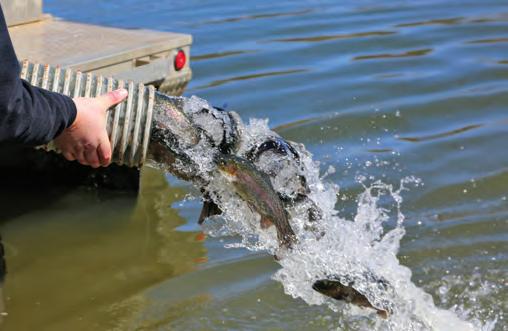
By increasing !sh stocking e orts, states could easily replenish popular game !sh species like red!sh, $ounder bass, trout, walleye, and crappie, ensuring that anglers have plenty of !sh to catch. is not only keeps !shing enthusiasts engaged
encourage a younger generation of anglers to be passionate about this wonderful pastime, they’ve gotta be able to catch !sh.
Many ecosystems are under constant pressure from habitat degradation, invasive species, and pollution. In some cases, native !sh populations struggle to maintain healthy numbers, which

America’s !sh stocking programs could and should play a critical role in maintaining healthy !sh populations, supporting the economy, preserving ecosystems, and enhancing food security. With increasing environmental and economic pressures threatening it’s time for a signi!cant investment in stocking e orts. By expanding hatcheries, improving stocking strategies, and integrating habitat conservation e orts, America can ensure that its waters remain abundant with !sh for generations to come.
Protect Our Waters is an angler-sponsored, nonpro!t organization with it’s primary focus on the sustainability and enhancement of recreational !shing. Learn more at ProtectOurWaters.com.








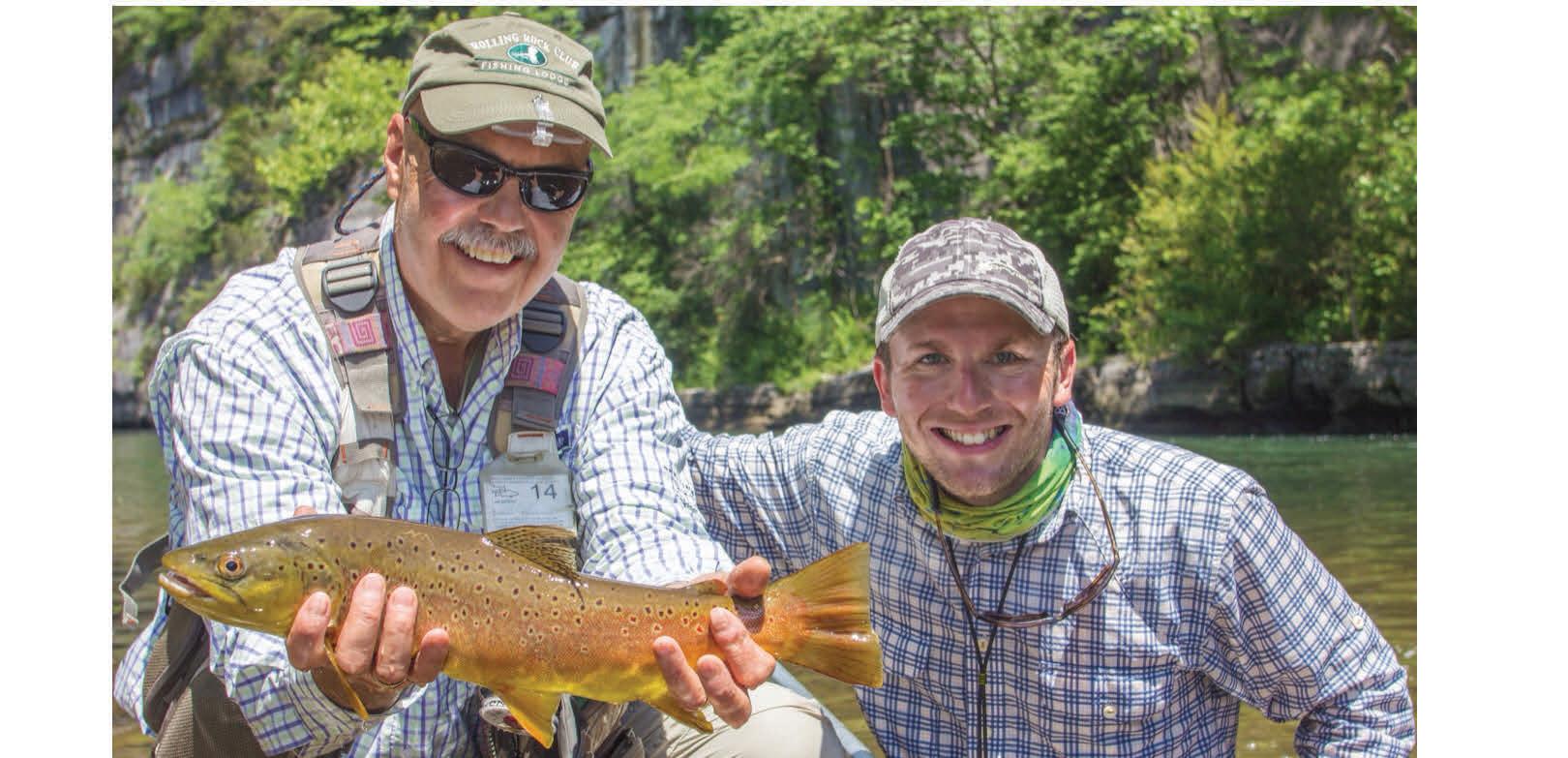




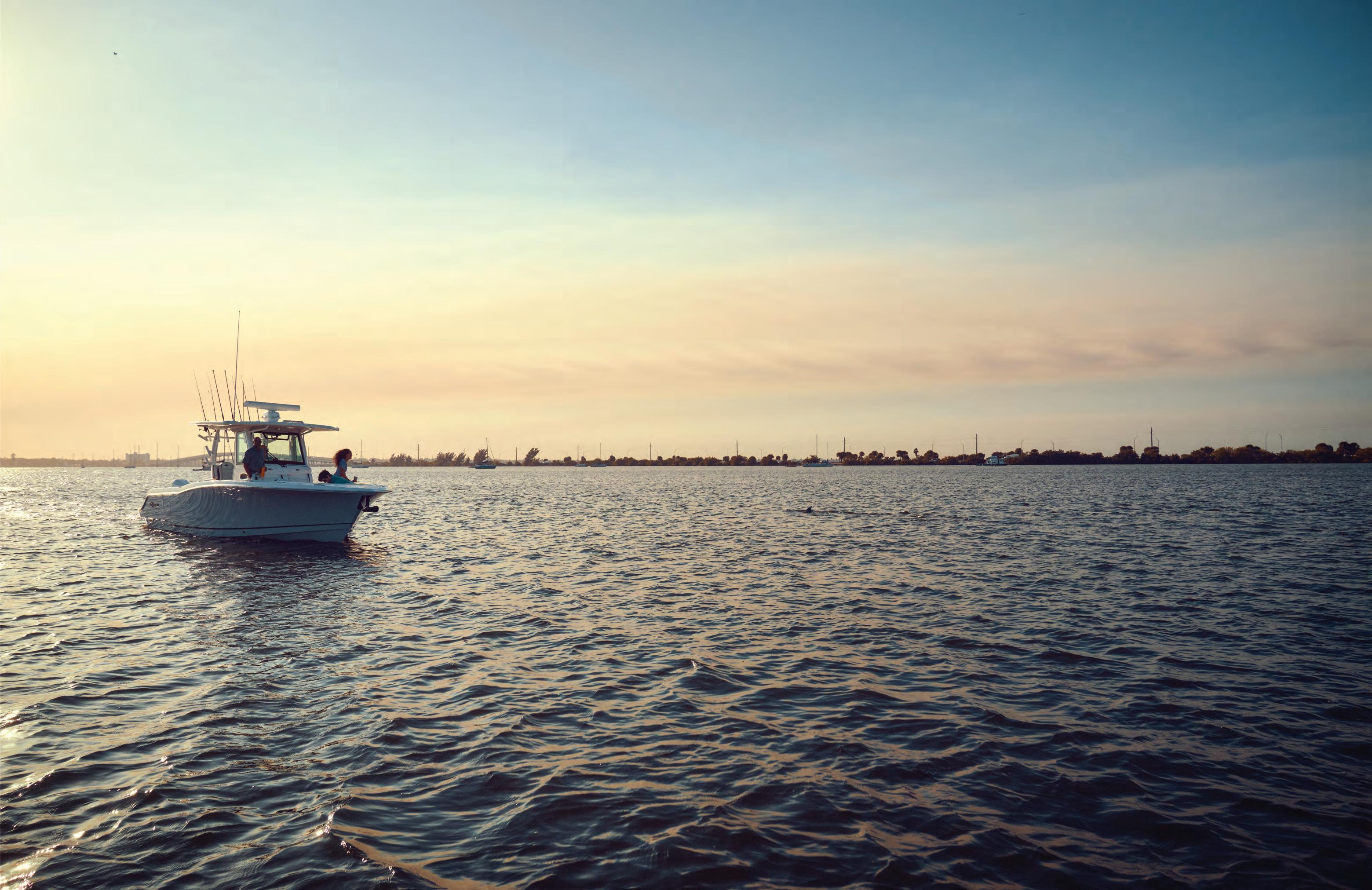
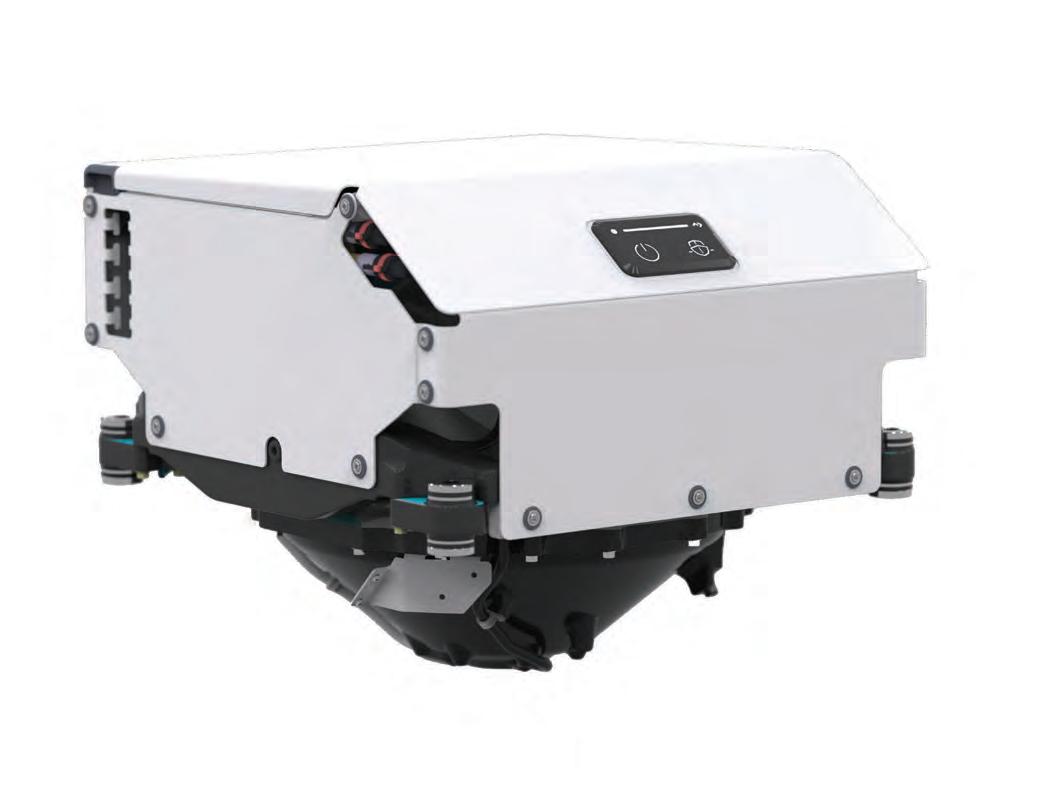



There are many reasons why the beautiful, deep-water queen snapper has made its way to the top of many anglers’ bucket lists. Not only is this !sh unique and stunning in appearance, but the quality of !llets it produces tops the scale of other snappers.
Most !sh that are harvested from the deeper, cooler waters, as with queen snapper, tend to yield higher quality table-fare. With the thick white meat on these !sh, that can grow over twenty pounds, targeting this species is a foodie’s delight.
Queen snapper can be found from 400 to 1,600 feet of water, spawning year round, with schools constantly on the move. Although they can be targeted over ledges and deep-sea coral beds within these depths, it’s not common to catch one as bycatch while not speci!cally intending to target them. As with most !sh with a penchant for these depths, research is scarce, with !shermen providing the majority of information on their observed behavior. at being said, targeting this species will be more productive with an experienced guide, rather than going it alone and winging it.
If you are a part of the DIY deep-dropping explorers club, and looking to add queen snapper to your hunt, you’re probably going to want to make a few di erent rigs for them.
An electric reel setup is recommended for this type of !shing. Not only due to the depths you are trying to reach, but you may only get short
By Capt. Quinlyn Haddon
dri%s over where you need to be before its time to reset.
e standard drop LEDs and lights should be used the same as with other deep-drop methods. Utilizing a heavy mono!lament leader line of approximately 300 pounds, a x your !ve drop lines at varying distances from each other. You may !nd you get bites higher up in the water column on certain days, making an extremely long leader more productive in !nding the !sh, especially on a !rst dri%. e drop lines should be decorated with your choice of glowing fandangles, whether it be glow wraps, rubber squids or the simple glow beads. Circle hooks ranging from 7/0 to 10/0 are e ective, and if you choose to put a variety of sizes on a single rig, the larger hooks should be at the bottom of the line.

this type of !shing is new to you, pepper in a few chunks of skin-on bonita in your presentation.
If you happen upon your queen snapper territory and !nd yourself in conditions without much current, you can also attempt to catch them with a heavy slow pitch jig. As long as you have light braid and a heavy jig to get to the bottom, and the energy and tenacity to retrieve it again, this is a productive method in extremely light current.
Once you start catching !sh, you may !nd they are consistently eating the bottom hook or the top hook, you can then play around with switching your rig to a longer or shorter leader.
e ideal go-to bait for queens is squid, but since this is a so%er bait, its easier to miss the bite. If
Queen snapper can be found deep in the gulf, and in the Atlantic from North Carolina to Brazil. While they have hot spots in the Bahamas and deep within the Gulf, e Atlantic waters of e Florida Keys o ers the best opportunity to target these within the United States and with the most minimal travel time. With mahi season around the corner in the Florida Keys, this is a great time to start heading o shore for queen snapper, as it provides a chance to target mahi to and from the deep-drop spots. Give me a call to get out there!
Capt. Quinlyn Haddon guides with Sweet E’Nuf Charters out of Marathon, e Florida Keys. (504) 920-6342. www.captainquinlyn.com; IG: @captainquinlyn


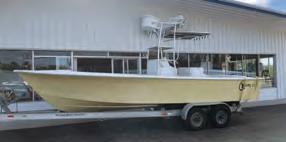
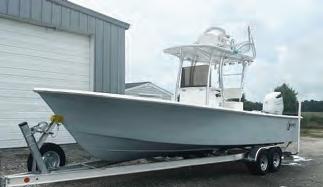




For anyone looking to build the best rod you’ll ever !sh, All-In-One Rod Building Kits from Mud Hole Custom Tackle are the ideal starting point. All-In-One kits take all the guesswork out of building a !shing rod, making it easy and enjoyable. Whether casting, spinning, y, or even ice, Mud Hole has everything you need for the perfect performance !shing rod and to start a lifetime of custom building.
Mud Hole’s All-In-One Rod Building Kits make it simple. Each kit includes everything you need—rod blank, guides, reel seat, grips, thread, and even the tools and supplies for assembly. With everything already preselected and packaged together, beginners don’t have to worry about picking out matching components and determining which supplies and tools are needed—all the work has been done by their professional builders.
Plus, Mud Hole provides all of the instruction required to build your !rst !shing rod. Kits include an easy-to-follow instruction book, and Mud Hole is the world’s largest source of free online rod building education material and content. ere’s nothing like catching a !sh on a rod you built. And All-In-One Rod Building Kits from Mud Hole Custom Tackle are the perfect way to get started in this time-honored cra$.
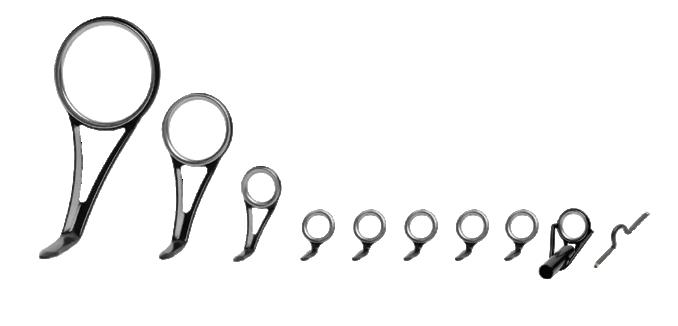
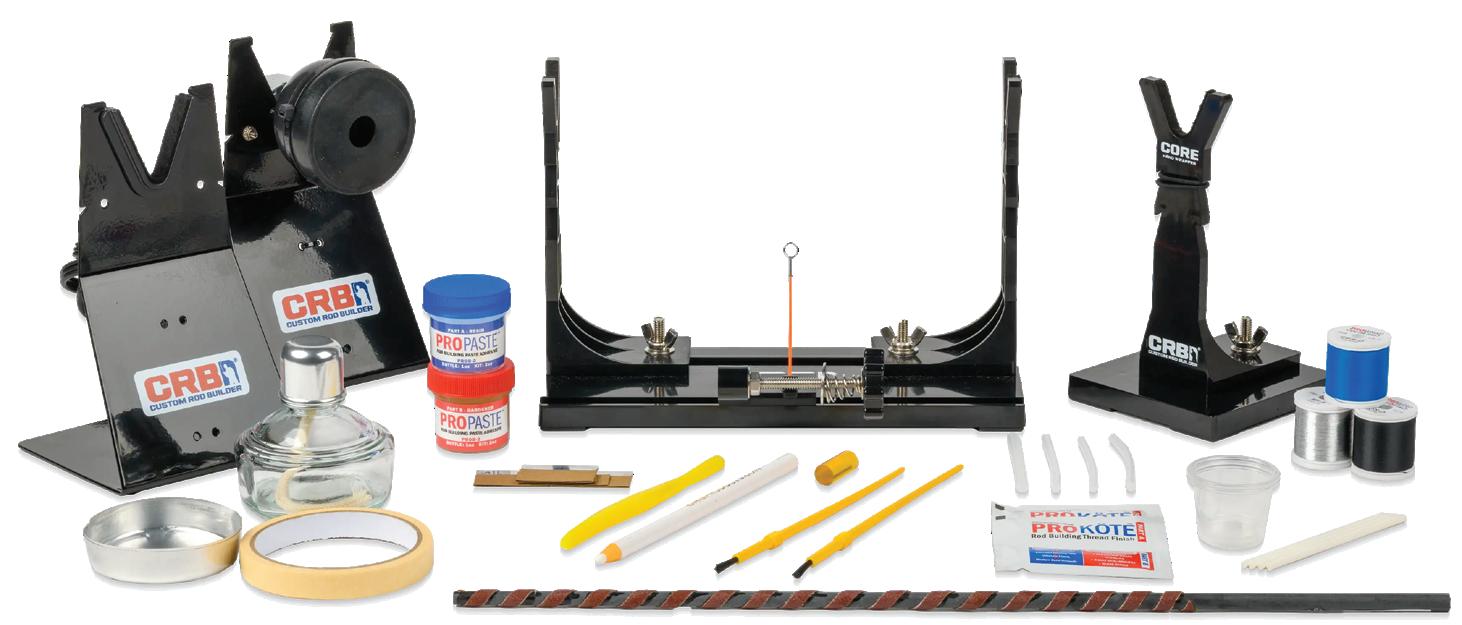


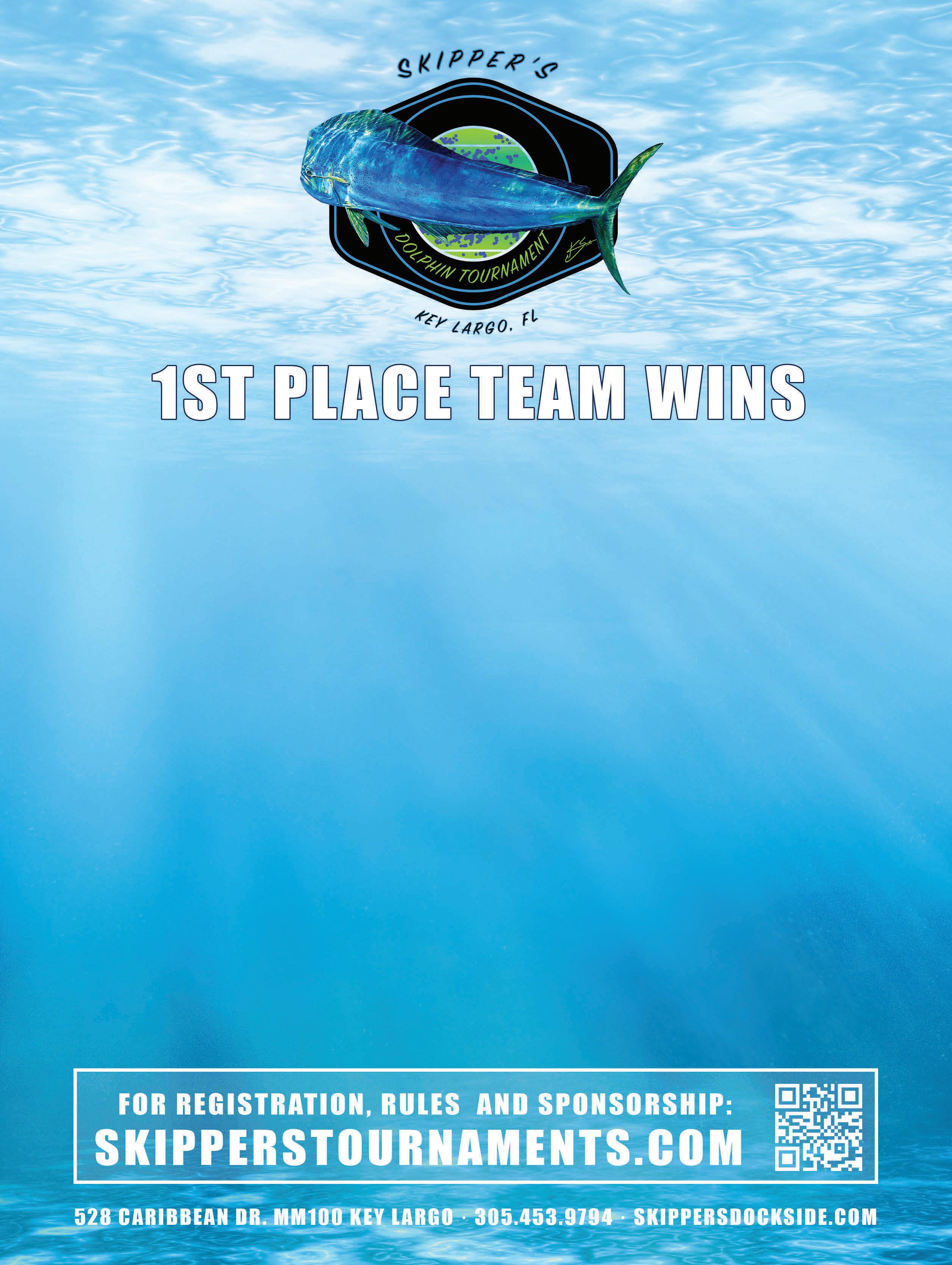
Performance Bulletin Available

Repower






The weather is warming, and the winterchallenged !shermen are pulling their boats out of storage. is undoubtedly will lead to more tra#c on the water. With the added tra#c and high southern winds, this is a perfect time for me to avoid both by swapping the kayak for the boat for a few weeks and going deep into the marsh.
Springs’ rising tides will $ood new water over the once-dry marsh, encouraging more !sh to explore the new terrain in a quest for a good meal. Little do they know, I will be waiting there with my trustworthy rattling paddle tail.
Red!sh will be my primary target since I spent the winter targeting trophy trout. As always, bait will be the key to a successful outing. Since the size of the bait will be small, I like to have two characteristics in my lure. ey are small, roughly 3”, and have a clear sparkling color. is helps produce in most situations because the bait is tiny, maybe smaller than my lure. at is why I like the transparent re$ective colors; they disguise the lure’s size, making it appear smaller.
I like to work irregular shorelines since they have more areas for the bait to hide. I also feel it slows the reds down. When they have a straight shore, they tend to cover more water rather than hang around, allowing you more opportunities. If the water is o -color, I like to add a popping
cork rather than changing color. Known for their e ectiveness when using live shrimp, popping corks also improve the performance of so plastics. Depending on the situation and preference, these can be used on a jig head, weedless weighted hook, or with just a hook. When choosing a popping cork, I like a deep cup, which is hard to !nd on most corks in today’s market, but there are a few. Most manufacturers went away from the actual reason for the name, popping. e original, and a few out there today, still have the deep concave top, which produces the slurping sound and splash mimicking a !sh feeding on the surface. I !nd that sound is what attracts the !sh more than a clack. I’ll dedicate an entire article to cork !shing and the many ways to use them soon. While targeting reds, use a stout hook on your jig head. A hook you can $ex with your !nger is better suited for trout than reds. is is not where you want to skimp on quality. Not only do the hooks need to stand up to the hookset into the thick skin of a red, but they also need to hold up to the torque of removing the hook from the their jaw. I see many hooks get destroyed at this point. ank you for reading my words and don’t forget to take a kid !shing! e time is right.
By Capt. Michael Okruhlik



Spring !shing is one of the most exciting times of the year. As water temperatures rise, !sh become more active, making live bait one of the best ways to trigger bites. A bait pen—a oating or submerged enclosure for keeping bait!sh alive— can be a game-changer for any angler.
One major advantage of a bait pen is ensuring a steady supply of live bait. Instead of relying on bait shops or spending time catching bait before each trip, you can stockpile bait in advance. #is allows you to head straight to your !shing spot with fresh, lively bait ready to go.
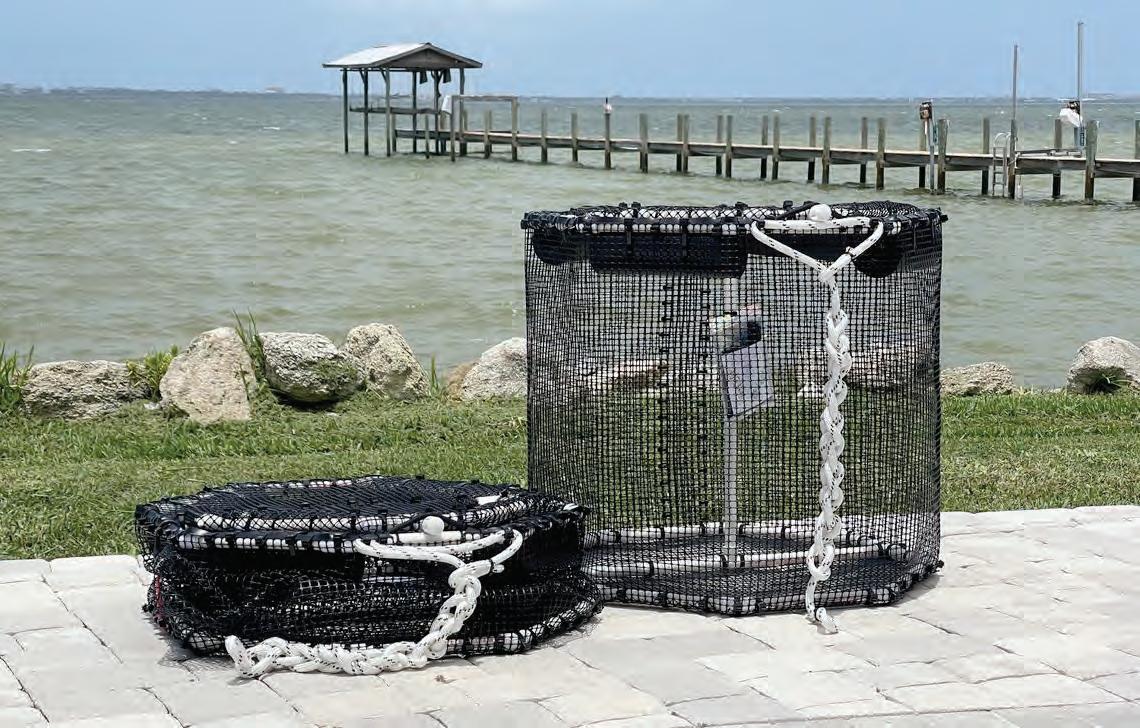
A bait pen also saves time and money. Buying live bait regularly can be expensive, especially during peak !shing season when demand is high. Catching fresh bait every time you !sh also takes up valuable time. By storing bait in a pen, you reduce costs and eliminate the hassle of searching for bait before every outing.
Healthy bait is crucial for successful !shing, and a bait pen helps keep bait!sh strong and active. With proper water ow and oxygen levels, bait stays in peak condition for days or even weeks. #is means your bait will swim naturally and attract more strikes compared to weak or dying bait!sh.
Another key bene!t is exibility. Spring weather can be unpredictable, with sudden changes in wind and tide conditions. If a !shing trip gets postponed, a bait pen allows you to keep your bait alive until conditions improve. Instead of scrambling for fresh bait when the opportunity arises,
you’ll be ready to go at a moment’s notice.
Using a bait pen is also more sustainable. Instead of constantly netting fresh bait and impacting local !sh populations, you can responsibly store what you need and reduce unnecessary waste. #is helps preserve bait!sh stocks while still giving you an e$ective !shing strategy.
For tournament anglers and !shing guides, a bait pen is an essential tool. Having premium live bait ready before a trip provides a competitive edge and enhances client experiences. Instead of spending time chasing bait, anglers can focus on putting more !sh in the boat.
A bait pen is a simple but invaluable tool for any serious angler. It ensures you always have quality live bait on hand, saves time and money, and provides exibility for unpredictable !shing conditions. Whether you !sh recreationally or professionally, investing in a bait pen will make your trips more e cient and successful.




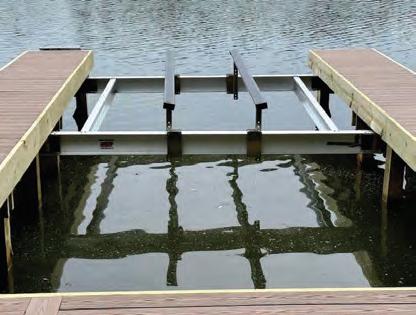

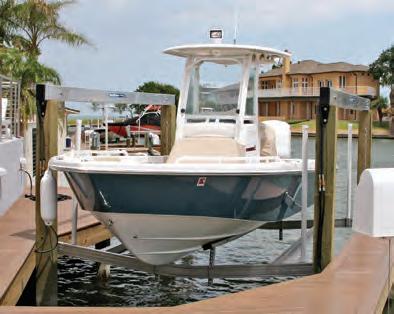


ShoreStation hydraulic boat lifts are a reliable choice for coastal residents and boating enthusiasts alike. Their strong construction, made with corrosion-resistant materials, allows them to withstand harsh environmental conditions, including sun, storms, and saltwater damage. ShoreStation provides a steadfast solution for protecting waterfront investments, o ering peace of mind to owners in the Sunshine State.


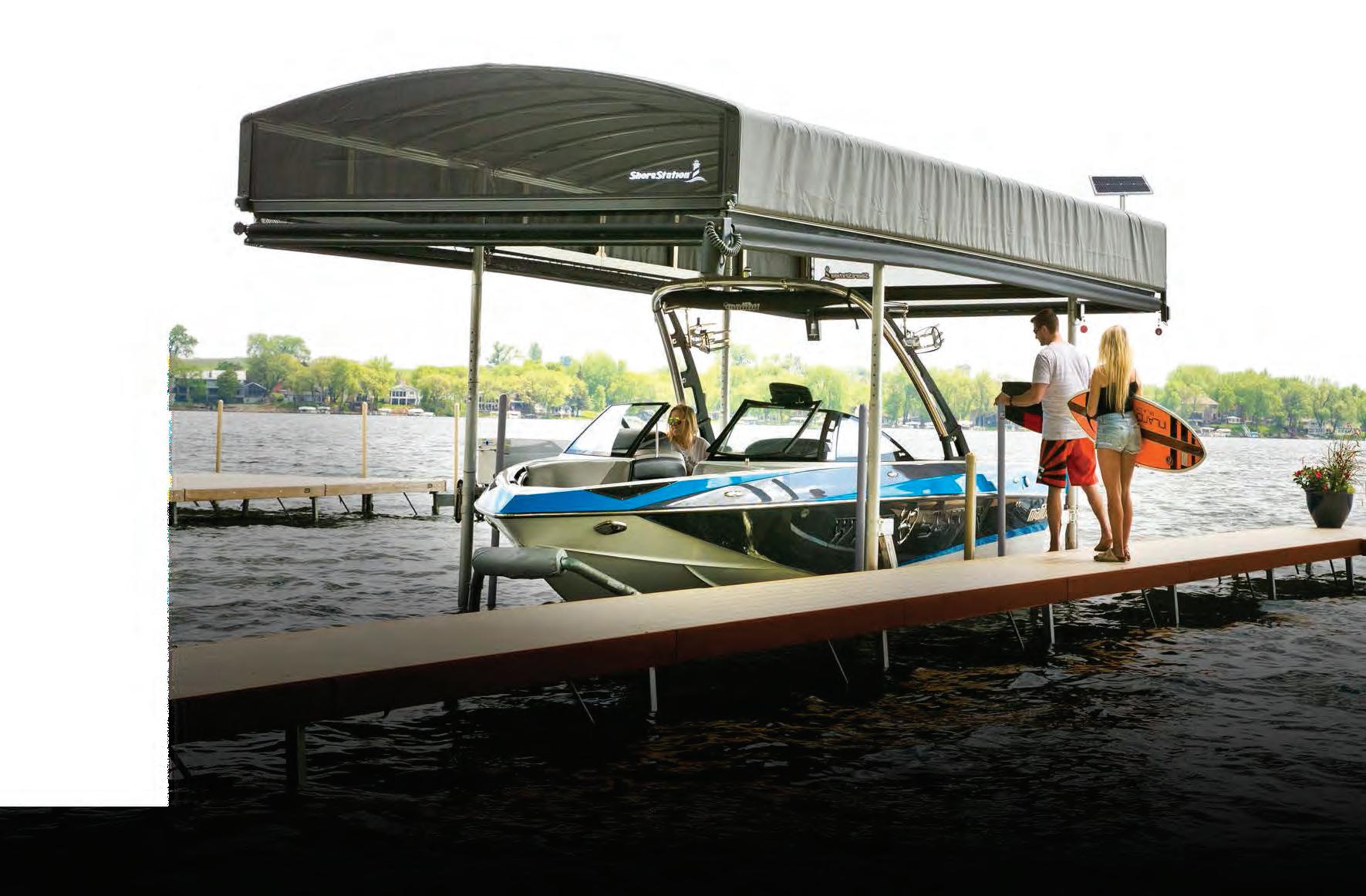

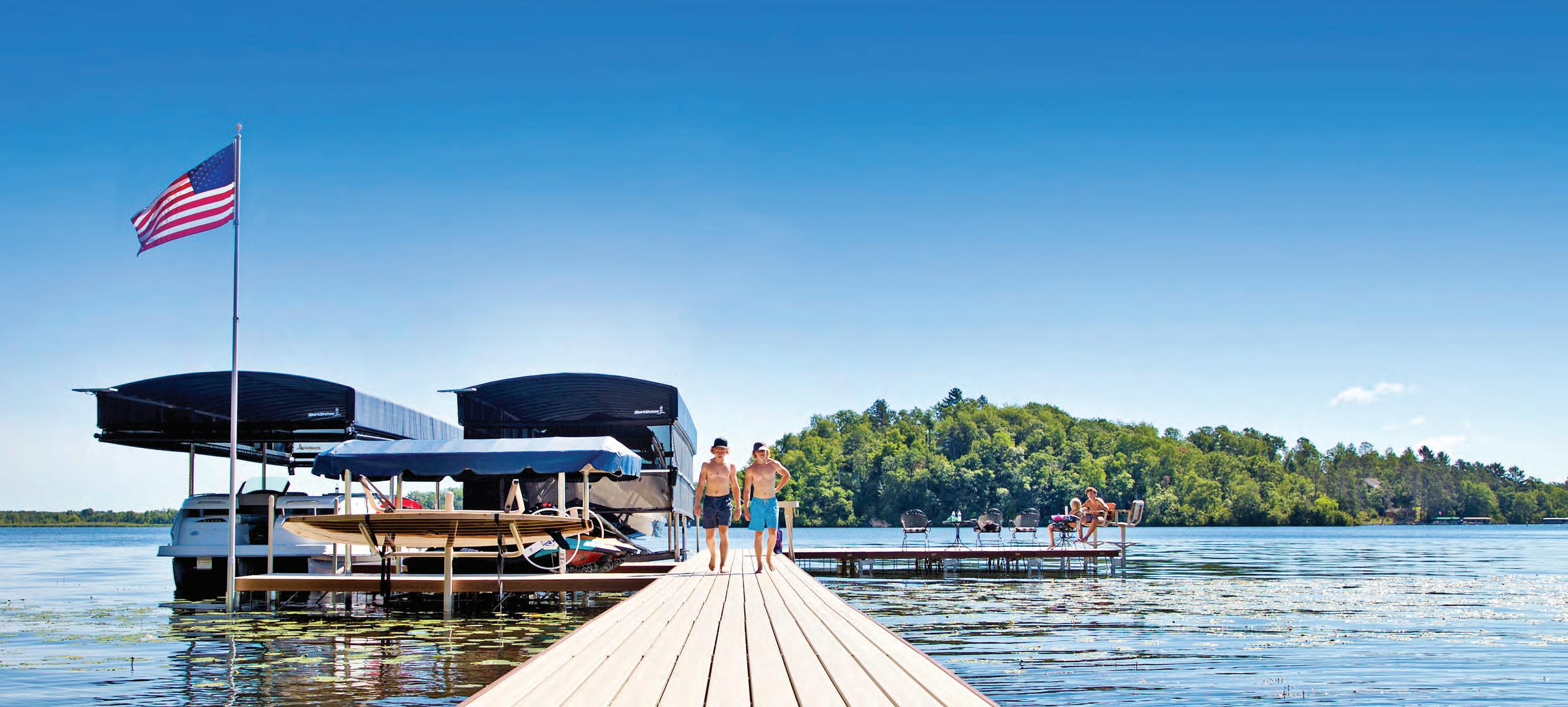



Equipped with exceptional weather resistant fabric and breathable SunTex 80 woven mesh ends for maximum protection and durability,

Made from the highest quality materials, our innovative hydraulic boat lift is one of the fastest and safest lifts on the market today. When you have a hydraulic lift, there’s no need to worry about wind and waves getting in your way. This lift will give you con dence to safely land and secure your boat in less-than-ideal conditions.
Never miss another moment on the water. Power your lift with clean, free solar power. Our speedy 20 watt charger features solar regulator drainage protection, saving your battery from permanent damage caused by overcharging.



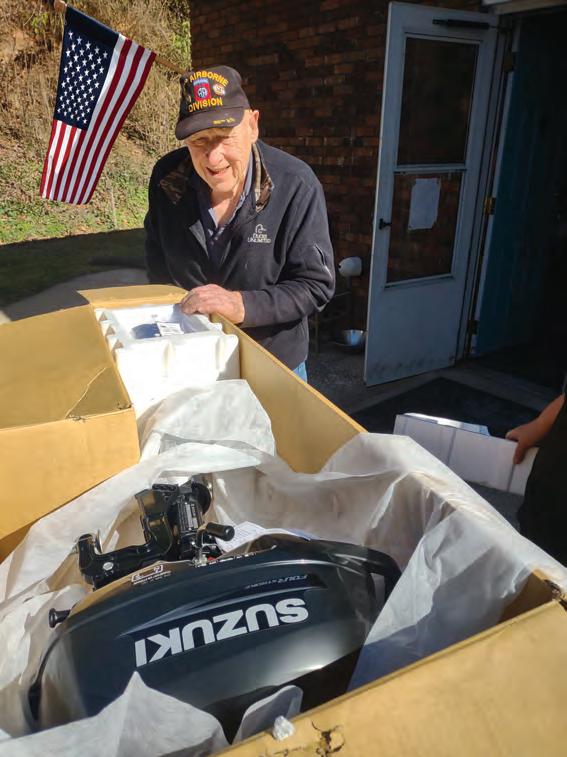
For more information on future contests, visit
We’ve all heard it, and most of us have said it at one time or another, but on March 3rd, 2025 George Poemer of Robbinsville, NC, received his Coastal Angler Magazine contest prize: a brand new Suzuki Marine DF2.5 Portable Outboard Motor! Now, at least one of us out there can never say, “ I never win anything,” again. Congratulations to George for being chosen the winner, and a special shout out to our friends at Suzuki for making this really cool contest possible. www.coastalanglermag.com



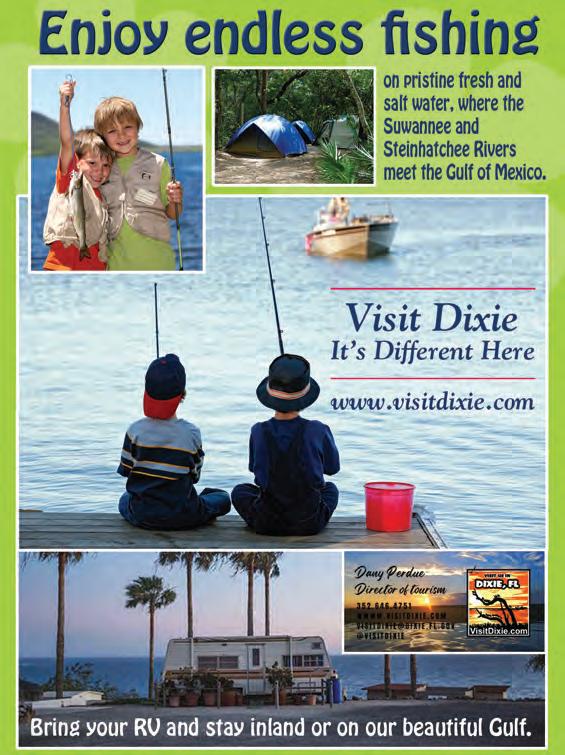
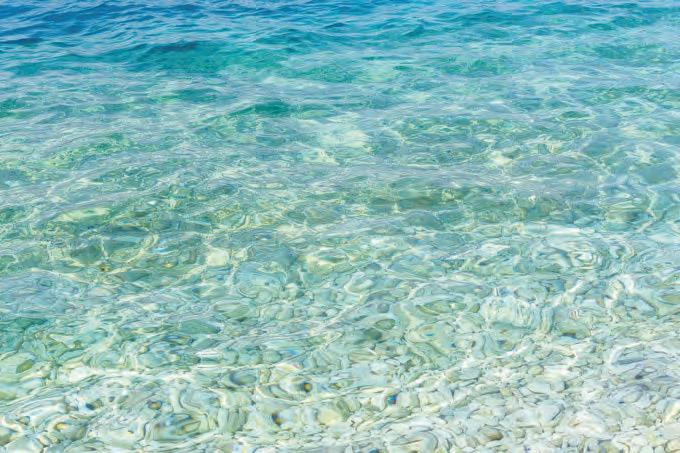








First things first, just a friendly reminder: It’s an oyster bed, not an oyster bar! If you want some raw oysters and a cold beer, head down to your local oyster bar. If you want to catch redfish, snook and maybe a monster seatrout, grab a rod and find yourself an oyster bed. Capeesh?
Oyster beds are prevalent throughout Tampa Bay and are one of the most productive natural structures to target redfish and snook. Now that we’re experiencing higher tides, more oyster beds are accessible. Not all oyster beds are the same, however. Some are way up on the grass flats against the mangroves, while others are along the edges of channels or canals.
While fishing along some oyster beds adjacent to a drop off in a channel, four Spanish mackerel were caught by some of my clients on February 28. Those mackerel were the first caught this year, and probably the first ever landed aboard Afishionado during February. A few days earlier, I was fishing in the same spot
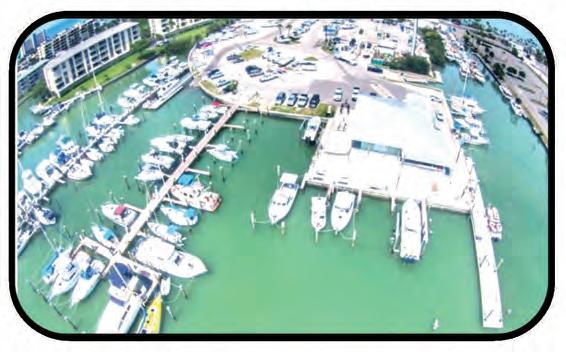





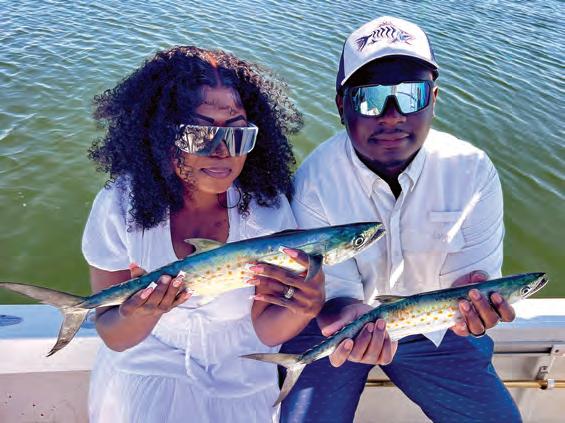
and caught pompano; so, my first reaction was, they’ve just hooked a pompano. I was pleasantly surprised when it turned out to be a Spanish mackerel. Not only can you catch Spanish mackerel and pompano adjacent to oyster beds along the edges of deep-water drop offs, sheepshead are known to feed in these areas also. Barnacles cling to oyster beds and everyone knows sheeps-
Continued on page 6


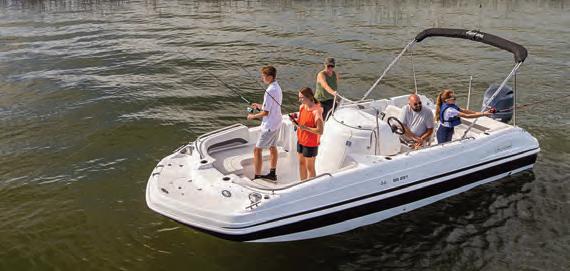



BY: CAPT. ANTHONY CORCELLA





337 Bahia Vista Dr. IRB, 33785 | vistabandb@gmail.com vistabnb.com | 813-477-3747



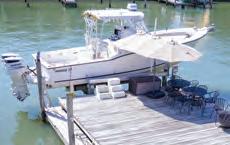
Hurricane damage was minimal, and the Vista Beds & Beaches is back in business. The doors opened again on February 1, 2025. We cater to the fishermen, as well as, all vacationers. For the fishermen, we offer cleaning tables, boat dock, commercial ice machine, coolers, wash down, buckets, soaps, brushes and much more. Everyone can enjoy a hot tub and pool with a heater and a chiller, outdoor shower, towels, music, beach chairs, sunbathing chairs, umbrellas and so much more. Don’t miss out! Book early for your next fishing tournament. We even offer discount pricing for booking all five rooms.
While you’re in the area, check out the original Crabby Bills on Gulf Boulevard. Dress casually and grab a beer at the loading dock. For fine dining, you can’t go wrong with the Salt Rock Grill or Island Way Grill. Stock up on live bait, tackle and gear at any of the nearby tackle shops. Bookings are going crazy, so book now in advance to reserve your room.


Oh yeah, it’s that time of year again-springtime. Are you ready for the kingfish bite? We sure are. That’s right, during the spring, we love fishing for kingfish, mackerel and mangrove snapper. I have a funny feeling that this is going to be the year for big fish in the Tampa Bay. With that said, let’s get into the tackle side of things. Let’s talk about the kingfish rods, reels and tackle. I usually use a 7’6” medium heavy spinning rod with 6000 or 8000 size reels with 30-pound braid and a 25-pound shock leader about six feet long. In Tampa Bay, use a #2 or #3 wire leader with double treble hooks.
The bait of choice would definitely be live threadfin hearing or blue runners. Some people like using small ladyfish and pinfish. You want to “match the hatch,” if you know what I mean.
The magic speed for trolling is about two miles per hour. Usually, we have three to four rods out. One of those rods should be in the white wash of the motor. Sometimes, you get the bigger fish right there close to the motor. I look for hard bottom in the channel. I’ll make one or two passes looking for mid-water fish. Usually, I can pick them out when I see them on my Lowrance fish finder. It usually doesn’t take long to find them.

After you get your limit of kingfish, find a nice hard bottom spot in the middle of the channel for some mangrove snapper action. That’s how you finish off the day. Remember, if you’re looking for the sharpest knife, check out those bad Relentless fillet knives!
— What makes our charter service unique is that we cater to disabled veterans and wheel chair bound clients! Our boat is able to accommodate wheelchairs and is ADA compliant. IF YOU’RE A DISABLED VETERAN, YOUR TRIP IS FREE! This is our way of giving back to our veterans.
Capt. Anthony Corcella, Pocket Change Inshore Fishing Charter 727-432-6446 www.pocketchangefishingcharters.com Check us out on Facebook, Instagram and TikTok


Butterflies have been sought out by collectors, photographers and wildlife enthusiasts for centuries! One of the most well distributed and well known of all butterflies is the Monarch Butterfly.
Monarch Butterflies range throughout most of the United States and in neighboring countries. Some migratory Monarchs make long migrations that span several generations per one-way trip. This means an adult will die during migration and the next generation will pick up where the parent left off.
The host plant for these butterflies is milkweed. Milkweed has a milky substance within the flower that is very nasty and even poisonous to most insects, but it doesn’t affect the Monarchs. Monarch Butterflies start life after an adult lays an egg on the leaves of a milkweed plant. The egg hatches into a larva and forms a caterpillar. The caterpillar will munch on the leaves of the milkweed, at times eating all of the plant above the ground.
Once the caterpillar is large enough, it will travel to find a harder substrate to form a pupa--also referred to as a chrysalis. An adult will eventually emerge from the Pupa starting the cycle all over again!
Look for milkweed like this Scarlett Milkweed (pictured) in area parks. If you find it, you will likely see the Monarch Butterflies too!

— Captain Wes Tallyn was raised in Florida and is a
and

Wes has a focus on conservation and education in the community and is the owner of Snook Jam Oudoors. You can find him on Instagram @snookjam or call 727-410-5853.

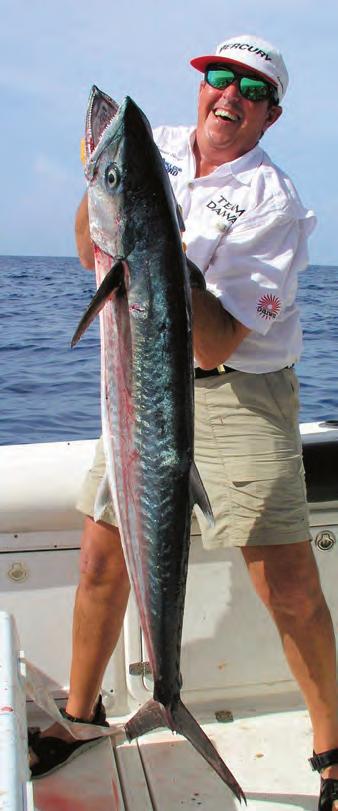
If all goes well, the water temperature is slowly working its way into the mid 70’s and you know it is kingfish and Spanish mackerel time. The longer days of spring and the warmer waters bring the schools of baitfish to the shallow Gulf waters. When water temperatures start to increase to 72-degrees, king mackerel start their northern migration, stopping to feed on the schools of sardines and cigar minnows along the coastline of Florida. Kings are caught each year from many Gulf piers, and they can be caught up to twenty miles from shore. This puts them within the range of the average angler.
Many anglers prefer trolling for kingfish. There is nothing like watching the fish strike and make that long first run, especially in the early morning when the water looks like a calm peaceful lake. Trolling allows you to cover more area, but
I would rather sit and chum. I have caught many a permit while anchored waiting for the kingfish to arrive.
Many ledges and artificial reefs can be found on Florida’s West Coast, especially between Tarpon Springs and Boca Grande. If you decide to drop anchor, make sure you are up-current from any ledges or reefs to prevent getting snagged. Getting too close to these areas can cause you to lose not only your rigging, but also your fish. By cutting some bait into small pieces and allowing it to drift with the current, king mackerel will quickly pick up the scent and zero in on the bait.
When drifting, first find a school of baitfish and start your drift up-tide from the school, while free lining your bait on the outer edges of the school. Repeat the process when the school is out of casting range. Using live bait, whether drifting or anchoring, will increase your chances of boating a king mackerel.
Live bait can be easily caught on the grass flats, along the edges of the channels or around channel markers. A 10-foot bait net is best for shallow waters and a 12-foot larger mesh net is recommended for deeper waters.
Baitwells are a necessity. Sardines require

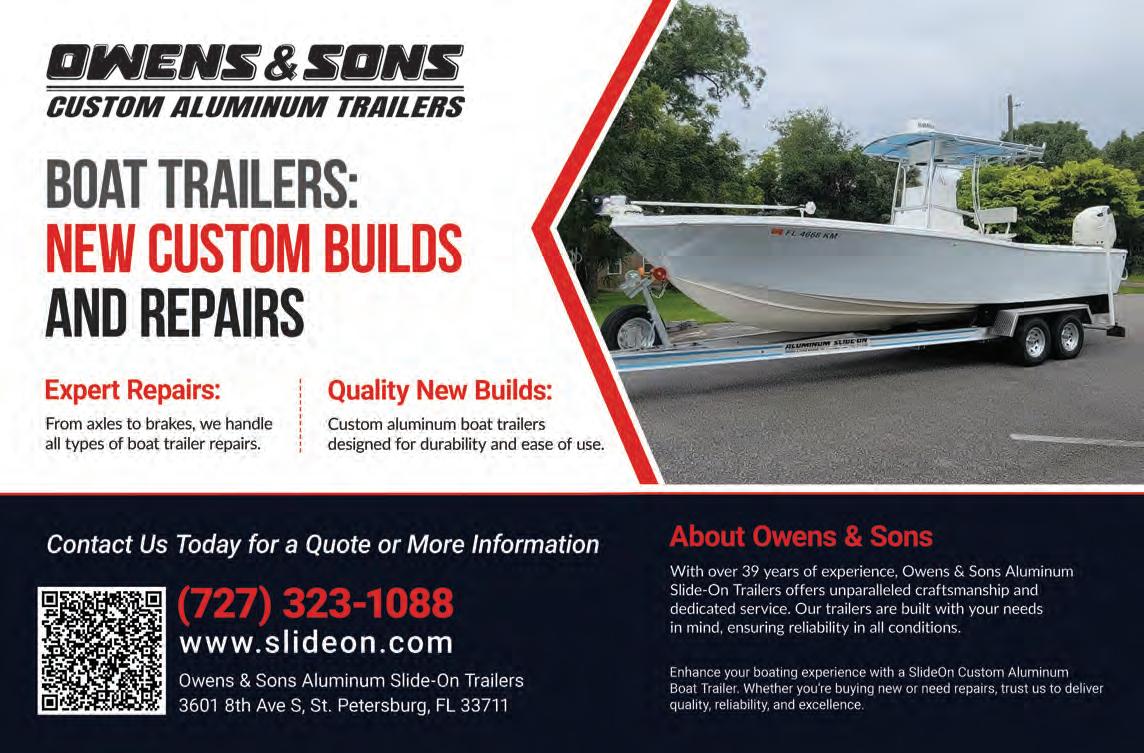
BY: CAPT. SERGIO ATANES

a large volume of moving water and oxygen to stay healthy. I recommend adding an aeration system to ensure lively baits. Several add-on systems are available for either bridge anglers or boats without baitwells.
King mackerel are fast swimmers that need a constant supply of oxygen to stay alive. Even a short period out of water can be fatal. It is important to be ready with gloves and pliers for a quick release. King mackerel have a 24inch fork size minimum and a 3-bag limit per day in Gulf waters. Keep only what you can eat, and release the rest for another day.
Anglers prefer to use tackle that ensures more boated fish. You can use 40-pound coffee colored wire, a black swivel, double hook or stinger reg tied to 40-pound 4-foot-long fluorocarbon leader with 40-pound braided line on a conventional reel and a 7-foot medium heavy rod. My personal preference is a medium spinning outfit, with a 20-pound braided line and a number 10-barrel black swivel tied to 40-pound fluorocarbon leader with a stinger rig.
Some of the best baits for big kingfish are blue runners and cigar minnows. Catch extra bait for chum, or just buy several boxes of chum. It’s well worth the investment in the long run.
Just a final note. Don’t try to be the first anglers on the water looking for kings. Catch your bait, make your chum, get your gear ready and then go looking for, what I call, the parking lot—a bunch of boats gathering in an area. They are telling you where to start your day--the rest is up to you.
God bless and tight lines.
— Capt. Sergio Atanes is host of Florida West Coast Fishing Report on Facebook and YouTube. He also hosts Fishing Adventures Florida TV show airing on YouTube, Waypoint TV, Carbon TV, Outdoor Action, and Angling TV. Owner of Reelfishy.com Charter business covering the west coast of Florida with over 135 captains on staff. For information contact Capt. Sergio at (813) 973-7132 email: atanes@msn.com.

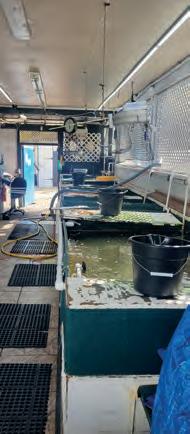





head like to feed on barnacles. The sheepshead spawn runs through the end of April, so they’re fairly easy to catch right now. Shrimp is very effective at catching she e pshead. Sheepshead will eat a whole live shrimp, half of a dead shrimp and frozen shrimp. When targeting sheepshead, I always do a little chumming to attract some fish. I take leftover shrimp from previous charters, freeze them and use pieces of them for chum on my next outing.
Since springtime has kicked in and the negative winter low tides are over, we can now access more grass flats for longer periods of time. Redfish love to hang around oyster beds to feed. On a good incoming tide, I will position my boat within casting distance of an oyster bed and start chumming with live bait. Once I’ve chummed a bit, I’ll place a bait under a bobber and have


people cast it out. Usually, it doesn’t take long for the bobber to disappear. Then, it’s just a matter of reeling until the line is tight for a solid hook set. When I’m approaching an oyster bed on a grass flat, I’m constantly scouring the flat for schools of mullet. Mullet are a dead giveaway for the potential that redfish might be mixed in. Mullet stir up the bottom as they feed on grass and flush out bait fish, shrimp and other small crustaceans. Redfish travel along and scoop up whatever the mullet spook.
Snook have already moved out of the back country, creeks, rivers, residential canals and channels and made their way back onto the grass flats and are feeding in force. Oyster beds adjacent to mangrove points with a deep-water drop off are excellent spots to hook a monster snook. So are oyster beds that line a passageway through a cut.
Occasionally, you’ll catch a nice spotted seatrout around an oyster bed too. For the most part you don’t encounter large schools of seatrout along the beds, but the ones you do catch can be huge. It’s common to land seatrout in the 20-inch plus range that are hanging around the oyster beds.
April marks the end of strong passing cold fronts, so water temperatures are continuing to rise. As I mentioned last month, everything revolves around water temperature, when it comes to fishing. Now that April has rolled around, the inshore fishing is off the charts.
In closing, the next time you’re thinking about heading to an oyster bar, leave your rod and reel behind.
Afishionado, “Adventures in Fishing.”
—Tampa Bay fishing guide Wade Osborne of “Afishionado Guide Services” has been plying the waters of Tampa Bay as a professional full-time captain, since 1997. Capt. Osborne offers inshore fishing charters on light tackle spin, fly or plug. He also offers eco-tours with an emphasis on photography. For more info., visit Afishionado.com or find Afishionado Guide Services on Facebook and Instagram. Email: wade@afishionado.com Call/Text 813-286-3474






As a young man growing up in California, Doug took any and every opportunity to have a fishing rod in his hand. His passion for fishing preempted everything, until he entered high school where a jewelry making class was offered. He was a natural at fabrication and designing of jewelry and quickly gained an equal passion for both.
Fast forward a few years and both passions are still at the forefront of his very being. Doug has fished all over the world from Papa New Guinea to the Sea of Cortez to dugout canoes deep in the Amazon. And, after building a major jewelry business in California, followed a lifetime desire to live in Florida and moved here about eight years ago.
Doug’s ability to capture the details of so many species of fish so intricately, comes from those years of hunting them. And, he is also a tremendously talented fabricator of mainstream and highly artful jewelry for all purposes and applications. From engagement or wedding rings to custom designed “one of a kind” jewelry of any description, nothing is beyond his capabilities. Doug has even made pieces for celebrities while in California (he’ll be happy to tell ya all about them).
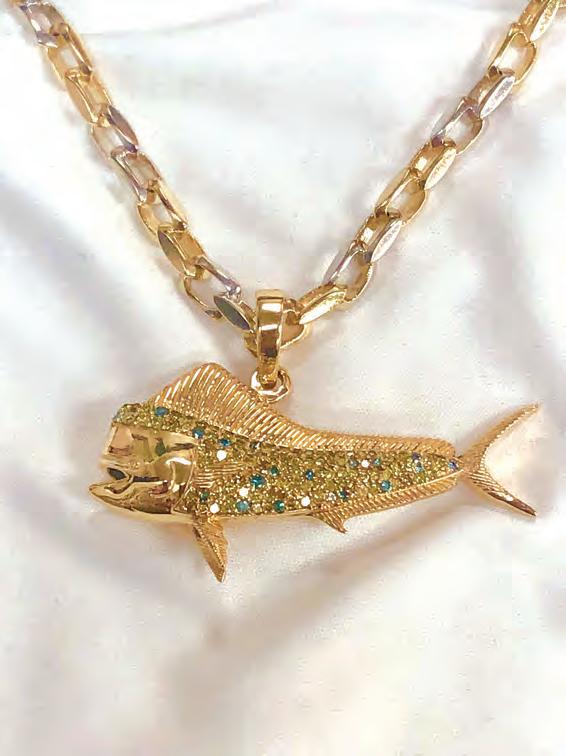

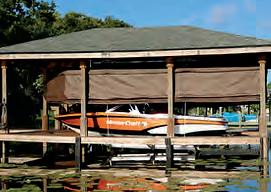
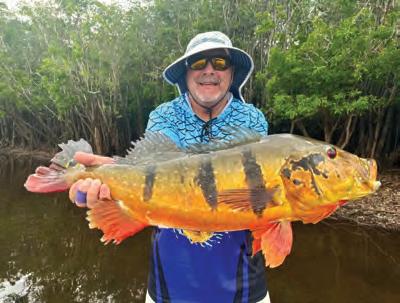
So, pick your favorite species, or bring in a picture of your “bucket list” trophy catch, and let him give you a quote so you can “wear your passion…with class.”






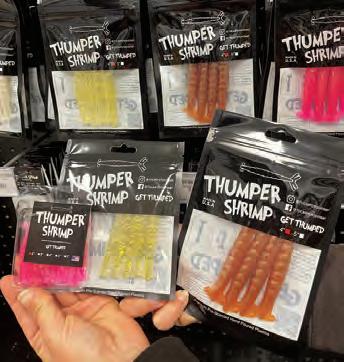







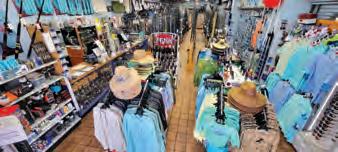




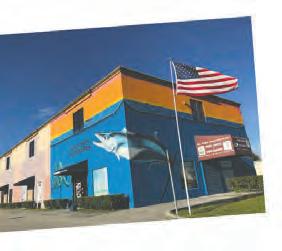




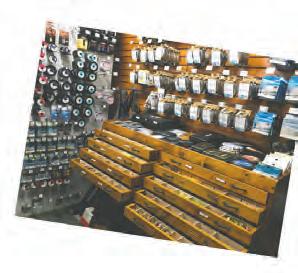


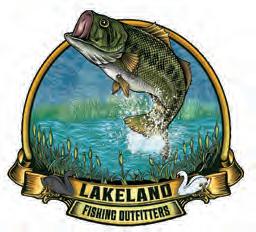







April normally brings water temperatures into the mid to lower 70-degree mark. This is an optimal temperature to really kick off the fishing party. Different types of bait will be showing up everywhere, but the scaled sardines will inhabit the flats which really turns on the feed bags for snook, trout and redfish. Out in the Bay, you will see plenty of threadfin herring dimpling the top of the water, but they will also be on many structures along with the scaled sardines--bridges, range markers, channel markers and rockpiles to name a few places. What this means is that many fish will come up into the

BY: CAPT. GEORGE HASTICK

As the sun comes up and the water gets warmer, they will move up onto the flats. Sometimes you will have larger trout in two places, at the drop off and up on the flat, skinny where the water is warmer.
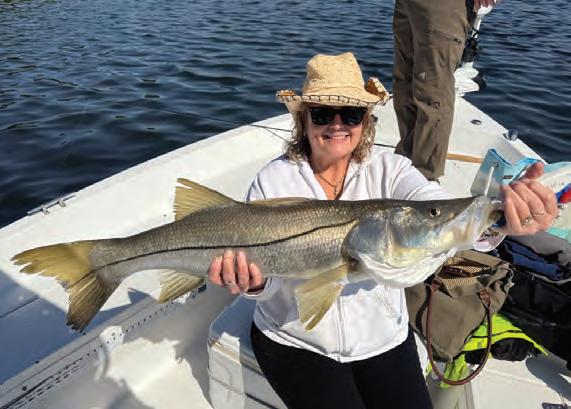
Redfish, many times, will travel back and forth along that drop off waiting for the tide to rise to get to that mangrove tree line or oyster mound that exposed during low tide. Try not to chase them if you see them--it will give them lock jaw. Instead, try to get ahead of them and set up within casting distance of the tree line or oyster mound. At that time, you can throw out some live chum along with a descent amount of cut baits to try to get them in your area. Having both visual and scent in the water will up your odds. Redfish have a very keen sense of ell that will help bring them to your chum. Now, set out a couple of rods with cut pinfish, threadfin, lady fish or anything oily, while fishing live baits on the other rods.
Once you have knocked the trout and redfish off your list, if the current is still flowing in, get to an area near the mangroves or a bridge that will usually hold snook. If the tide is slowing, you can find a funnel point where the tree line has a cut through it, or a larger body of water is coming into a pinch point where the current will pick up speed due to a narrowed area, to extend your chances of a snook bite. If you miss the current, do not worry. Once the tide turns to go out, all those same places will be feeding zones, with snook just
per, mangrove snapper, cobia and even some early tarpon.
Now that you have a good variety that you can target, let’s talk about getting that inshore slam of redfish, snook and trout. Let’s look at the tides and the effect the current has on the fish. Moving water is a key element to finding a good bite. Snook and trout are very much current influenced when they feed; reds are also, but they will still feed even during the slack--just not as good. That is not to say that you cannot catch them on a slack tide, especially if you are live chumming; but, the feeding frenzies almost always happen during tidal flow. I am not saying that, if a school of bait fish happens to swim into a school of snook during slack tide, that a bite wouldn’t happen lol; but, for planning your trip, we need to plan around the tides to have better success. In the area you plan to fish, if you can time the tidal movement with a major solunar, or during a sunrise or set, the bite will be better.
During April, most of the high tides are during the afternoon, depending on where you are fishing in the Tampa Bay area. So, I would target trout first thing in the morning when that tide first starts moving. Since it is low tide, many of the trout will be around the edges of the grass flat where it drops off.



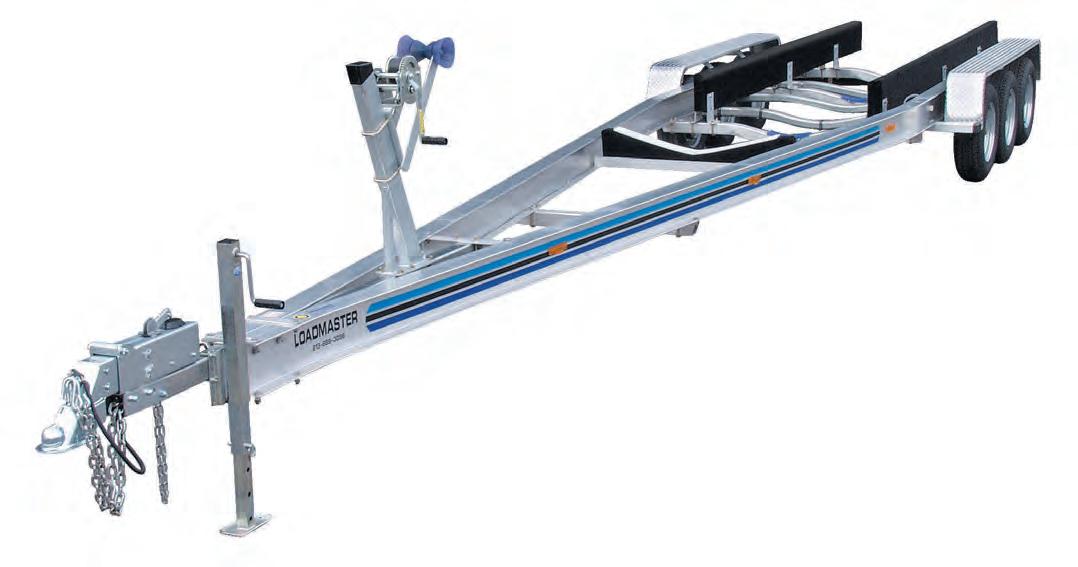



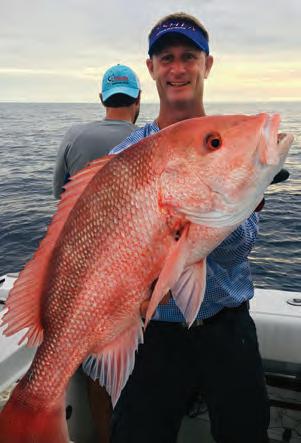
It was a perfect weather window in early March and I happened to have some great regular customers in town for business. Brian (Pennsylvania), Mark and Jeff (Michigan) and Eric (Ontario) were able to finagle a day away from meetings to head offshore for some much-needed salt water therapy. From their point of view, any trip was a much-improved way to spend a day over shoveling snow from their respective driveways. My bar is a bit higher.
I decided to run to an unexplored area I had marked last year that we passed over during our red snapper season. Exploring new numbers is always thrilling, and I had a good feeling that this gamble would pay off. Unfortunately, the reality of it being called “fishing, not catching,” hit us quick, and the first two spots turned out to be a complete bust. We gave each one about 10-15 minutes, dropping down a variety of baits with different leader thicknesses to no avail. Anyone who fishes in the Gulf knows that if you drop down a live shrimp on 20-pound leader and it doesn’t get a bite, it’s time to move on.
After a short 20-minute run to our second area, everything changed. Just as I was throttling down, the bottom third of the water column on our Raymarine Axiom Pro 2 XL24 lit up like a fireworks show. If this was an episode of Wicked Tuna, the pinging sound would have been echoing loud enough to hear from miles away. A trained eye knew we had found virgin red snapper bottom with
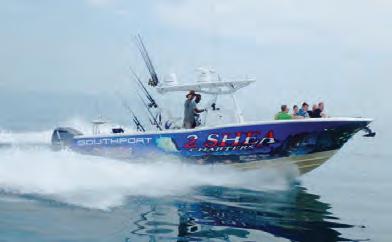



the only question being how many could give my customers a real battle. The group caught and released red snapper ‘till their arms could not take it anymore. We lost count at 70 with the biggest measuring in at an impressive 37 inches. As a bonus, we managed to get a few baits to the bottom that resulted in three lanes, a mangrove and two vermillion snapper in the box for dinner.
Our next spot was two miles away and, again, turned out to be a home run. This time, the cluster of fish on the sonar was packed tightly to the sharp rise off the sea floor. Our guess was that it was a wreck, and the school of jacks that greeted us supported that notion. Just like the red snapper from the previous spot, they chewed on everything we dropped, including cut bait we were attempting to get to the bottom for grouper or snapper. The guys went at it ‘till everyone had caught and released their personal best with one probably pushing triple digits.
We hit four more spots on the day. Two were, once again, loaded with red snapper, and we even managed to catch and release about a half dozen gag grouper well over legal size. The other two, well if I need 2-pound pin fish or sand perch in 160 feet of water I know where to go. We hit the dock 10 hours from when we began the day with great stories and pics to share, but a fish box that made it seem the day had been a bust. I am all for fisheries management, and this trip was proof that conservation works. For my northern customers, it would have been nice to just keep three or four of the 200 plus legal-size fish we released that day.
— Capt. TJ Shea. Owner/Operator 2 Shea Fishing and Diving Charters. TJ has been exploring above and below the Gulf of Mexico since he was 8 years old. Contact us at 813-385-2169 and at info@fishanddivetampa.com

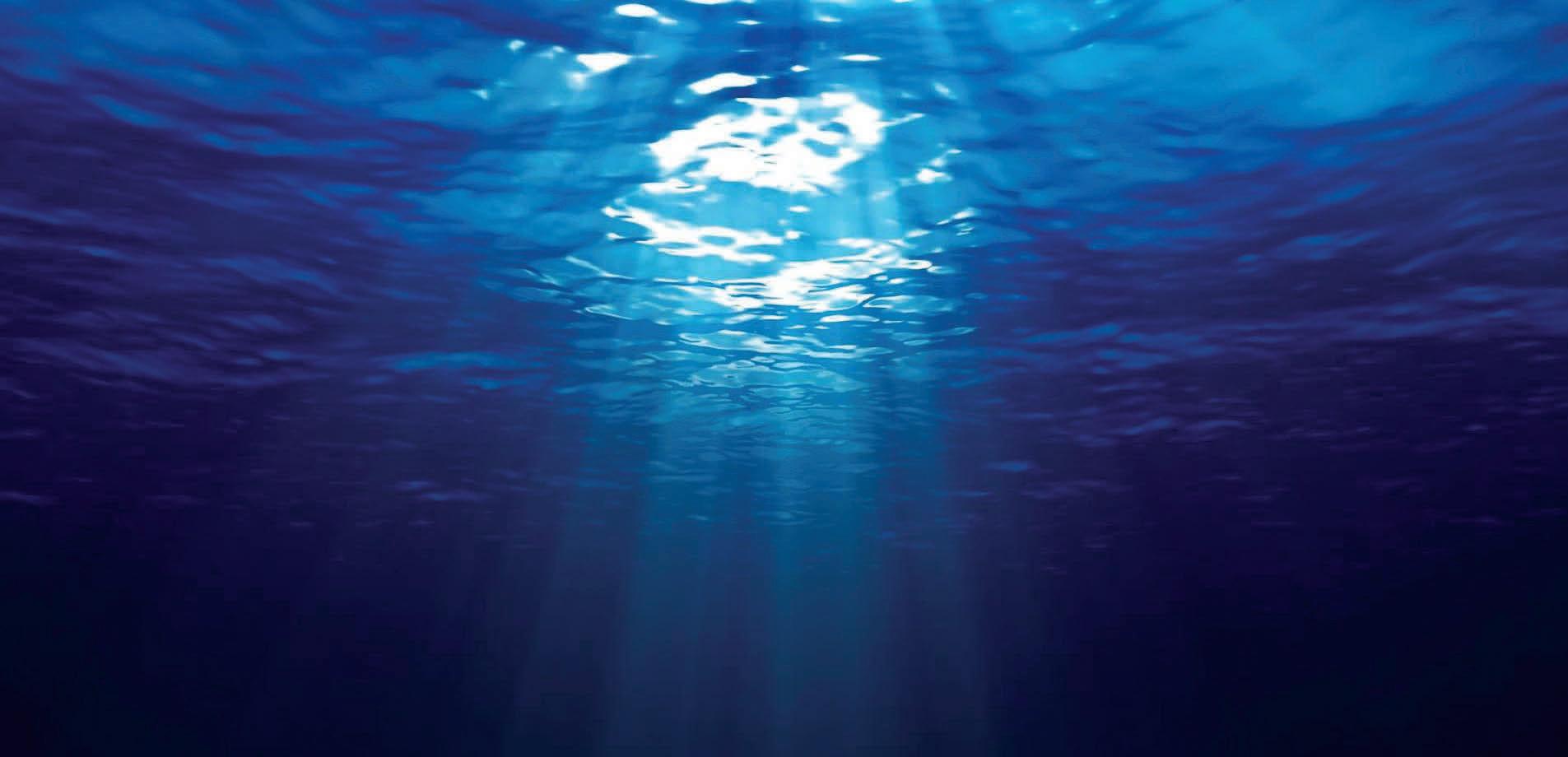


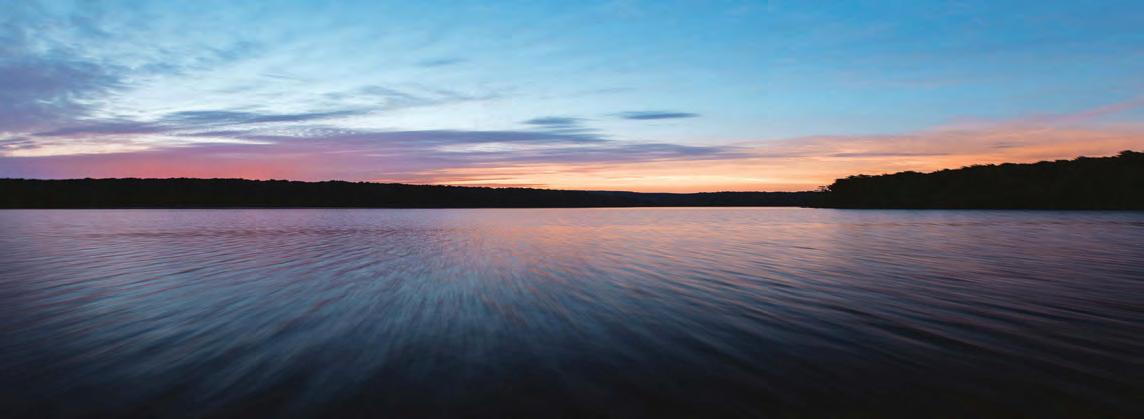




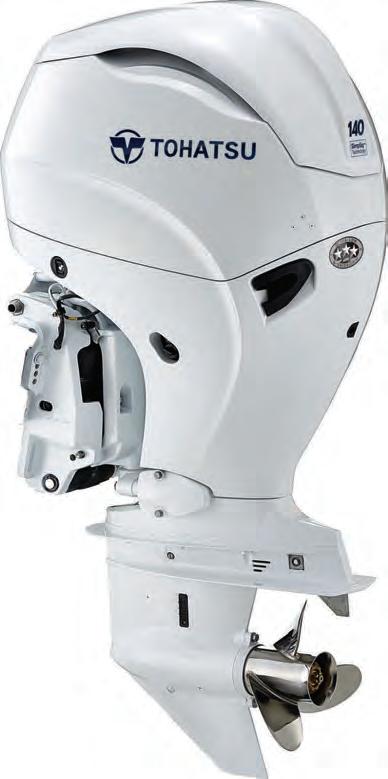
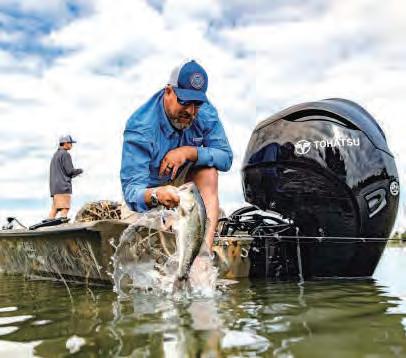


















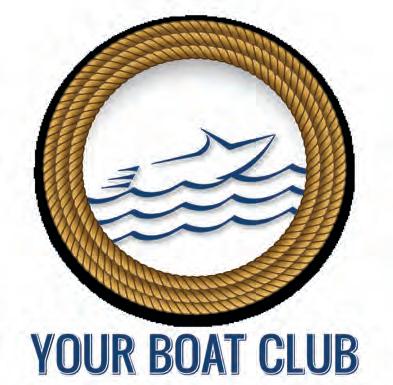





















9
8
5
1














12
14
15
18
19
20
21
22
23
24
25 Fri 11:30 2.7 5:45 0.4 6:08 0.0 6:54 8:03
26
27
28
29
Crab cakes are an old favorite- fast, easy and yummy.
Ingredients: (8 crab cakes)
• 1/2 red pepper chopped
• 1/3 of a cup of sweet onion chopped
• 16-ounce Lump crab meat. If canned rinse to get flavor back
• 1/2 cup of good mayonnaise
• 1/4 cup of Dijon mustard
































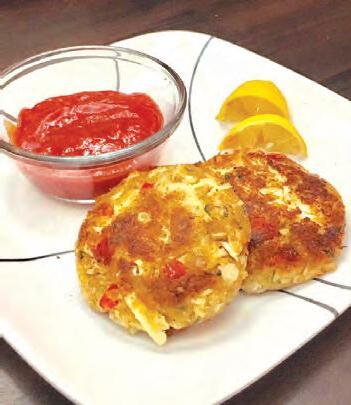
• 1 1/2 cups of bread crumbs
• Olive oil or cooking oil for sauté
• Dash of salt
• 1 tablespoon Worcestershire sauce
Instructions:
• Dash of pepper
Sauté chopped peppers and onions in olive oil until onions are clear--about 4 minutes.
Combine all ingredients and mix evenly. Make 8 patties using your hands to mold them. Heat oil to medium high heat. Place patties in cooking oil and brown both sides until crisp, but not burned. Place cooked crab cakes on paper towel to absorb excess oil. They are now ready to be served with a lemon wedge and your choice of sauce. A mustard sauce for stone crabs is my favorite. Cocktail or tartar sauce are also good choices.
Let me know what you think. Michelle: cnmoasis@gmail.com




















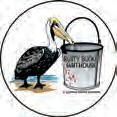


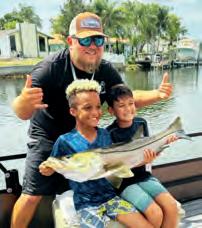






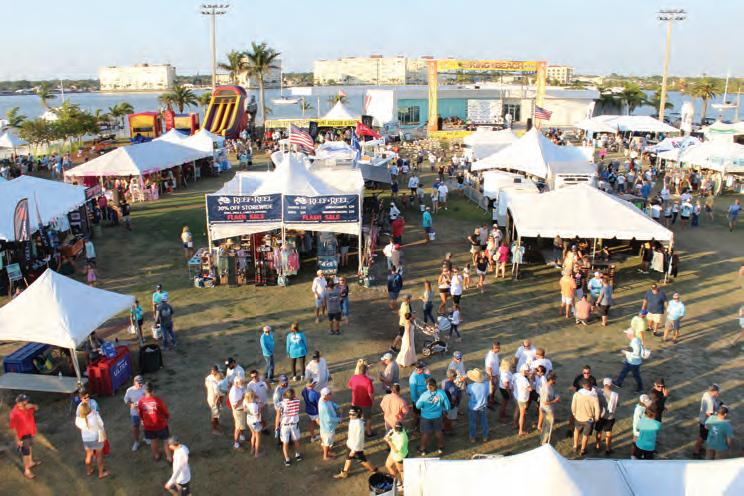
April 24-26, 2025
Have you ever tried tournament fishing? If so, you already know about the legendary “King of the Beach.” If you haven’t had the chance yet, this is your moment—this is the best tournament in town!
This spring, we proudly celebrate our 32nd Annual Tournament, and we’re taking the excitement to a whole new level with even more opportunities to win! This year, we’re introducing an incredible new prize: an Owen & Sons Aluminum Slide On Trailer with a whopping 10,000lb capacity, worth $10,200, awarded to the fish weighed in closest to 20.25 lbs. And guess what? Any team can snag this prize! This prize is winnable from any division, including youth.
Here are three compelling reasons why you simply must fish the King:
**LEVEL PLAYING FIELD:** Thanks to the Old Salts, our competition is one of the fairest for all anglers out there. We maintain a 30-mile boundary to ensure boats of any size can compete, and we provide additional opportunities for single-engine vessels. Plus, forget about intimidating checkouts or shotgun starts—this is all about fun!
**OVER 60 PLACES TO WIN:** With six divisions—Overall, Single Engine, Spanish Mackerel, Traveling Angler, Ladies, and Youth—there’s something for everyone! Each division boasts cash and/or prizes, with approximately $300,000 up for grabs. Our first-place prize for the single-engine division is a stunning new 200hp Suzuki with a repower package valued at over $20,250.

**LOW ENTRY FEES:** You can enter this fantastic tournament for as little as $300—almost half the cost of most Kingfish tournaments! That means less risk for you and far greater rewards. The overall first-place winner will be awarded approximately whopping $50,000! But wait—this event is about so much more than just fishing. It’s a full-blown 3-day festival featuring a variety of marine-related art and craft vendors, a vibrant food festival showcasing local flavors, and Friday night is Community Night, complete with a free Kids Fishing Slam and live music! “Bringing together a community food festival and live music into our tournament seemed natural to us. Fishing is part of our community, and we warmly welcome everyone to join us,” shares Old Salt President Tom Verdensky.
Don’t forget, the Kids Seawall Tournament is on Friday night! Our team will be ready to assist the kids in fishing and measuring their catches, and we have exciting prizes for each age group. Everyone has a shot at winning in our Kids Only Raffle, and the first 250 sign-ups will receive a free Rod/Reel combo to fish with!
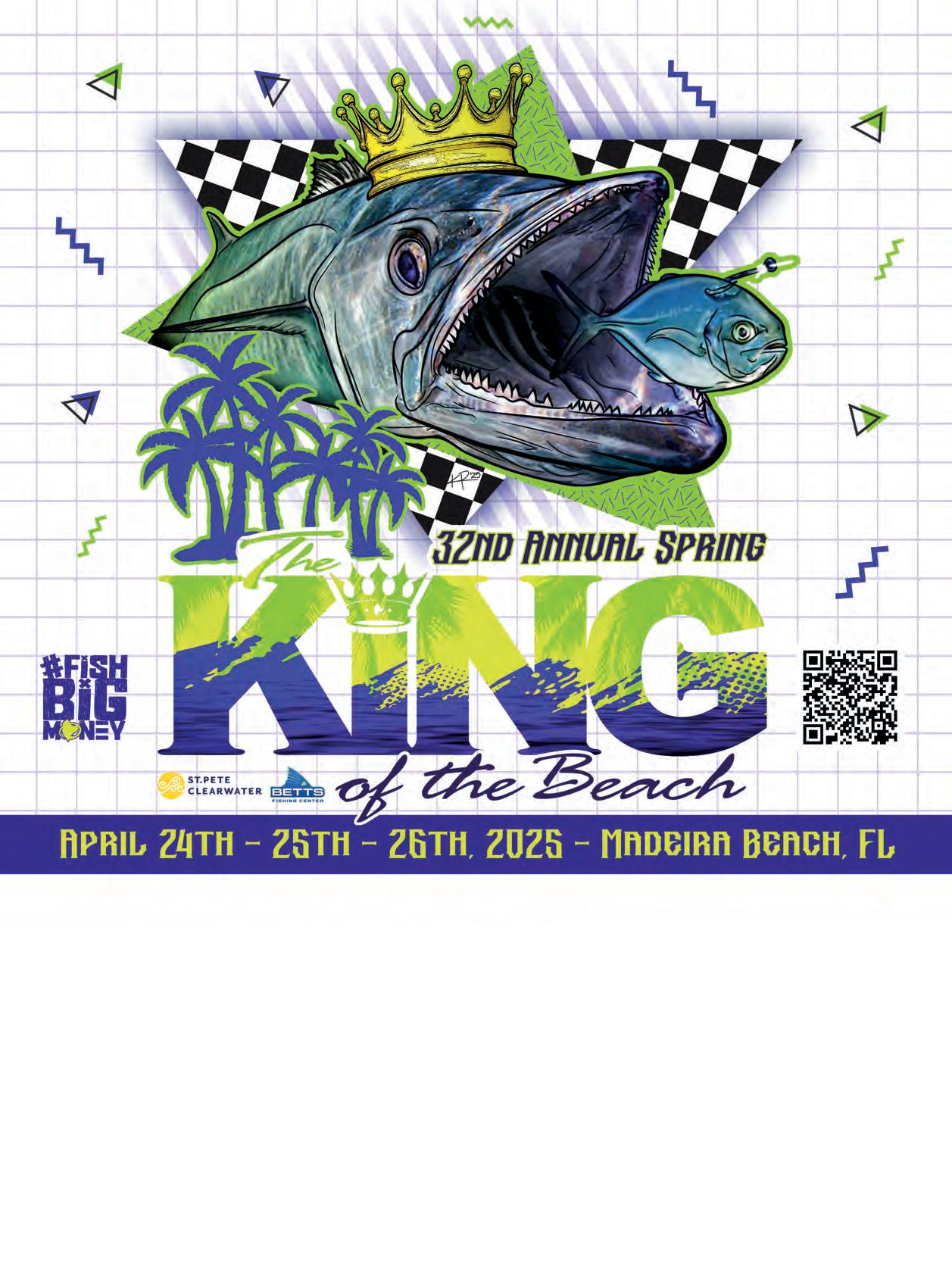
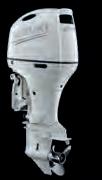

















Astand-up paddleboard (SUP) is a fantastic way to access shallow flats.
A SUP holds the same benefits as a kayak, as it has almost no draft and it’s small enough to explore thin winding channels. It’s also got something a kayak doesn’t have. Because it’s made to stand and paddle, the angler has an elevated position, which allows for a better view into the water. Whether your quarry is gator trout, tailing reds, cobia off the beach or even bedded bass in freshwater, that’s a huge advantage.
But SUP fishing is not something one should dive into headfirst, or one might literally take a dive with a bunch of expensive fishing gear. Many SUPs are designed to be stable enough to serve as fishing platforms, but practicing and
getting good with your SUP is advised before you load it down with a cooler and fishing gear.
Any wind or wave action can make balance very difficult on a paddleboard. Trying to fish just exacerbates the problem. This issue can be alleviated with the addition of an aftermarket outrigger. And sitting while fishing, either on the board or on an attached cooler, helps. Many SUP anglers, however, choose to venture out only in calm conditions. Calm waters are better for seeing fish anyway.
Another benefit of a SUP for fishing is they are extremely quiet, allowing anglers to glide stealthily into position to cast without spooking fish. They are also very good exercise, which some anglers appreciate, and they are lightweight and pack easily. A kayak requires all sorts of straps to tie it to the roof of a vehicle. In many cases a shorter paddleboard will slide right into the back of an SUV.

On the water, if you’re good enough
By CAM Staff
to hook a fish, there are some skills required to land it. Even smaller fish have the ability to pull a SUP. So, depending on the situation, the angler needs to be able to work the fish while also handling the paddle to manage the board’s movement. Storing the paddle in a loop of rope on your hip while fishing puts it in easy reach to do this, and it also allows the angler to quickly drop the paddle when it’s time to land the fish or have two hands on the rod and reel.
If the water is shallow enough, getting there on the SUP and then wading is a very good option; just be sure to tie the board around your waist, and attach the paddle to the board securely. Losing the board or the paddle could put you in a very bad situation.
SUP fishing might not be a sport for everyone, but if you enjoy paddleboarding as well as fishing, there’s no reason not to bring the two together. You might just find there are some significant advantages to it.



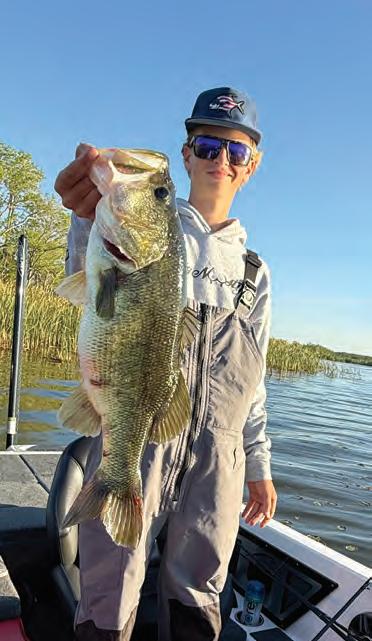
BY: CLAYBURN REED
Bass fishing and the weather are heating up here and throughout Florida in the month of March. Bass fishing has been great recently, with some more consistent weather and with water temperatures being more stable.
The bass are still spawning, but a great post-spawn bite is starting to form. The bluegill are also starting to spawn, from what I saw on our last trip. This is calling for the bass to get into their post-spawn phase. To find these post spawners, look around and out from spawning areas with structures like brush piles, vegetation, contour changes and hard bottom areas like shell bars. These fish will start to get focused on eating, as they are looking to replenish the exerted energy they use spawning. Also, be on the lookout for a shad spawn in the morning on hard cover and vegetation areas. To find shad spawns, the biggest indications are diving birds and flickering shad on top of the water. This bite doesn’t last long, but it can call for some insane mornings of fishing.
Some of the main baits I use to target post spawners are a lipless crankbait, a deep diving crankbait, chatter bait, dropshot or a jerk bait. For those shad spawns, I like to throw soft plastic flukes, swim jigs, soft plastic swimbaits and spooks.

Be sure to cover a lot of water during this time of year with these lures, as the bass will be grouped up in schools. There can be a lot of dead water around. The best way to find some of the groupedup fish on hard bottom is to use the side scan as a tool to mark schools, and use mapping to turn around and properly line up on them. You can also make use of forward-facing sonar to properly line up.
— To book a trip or for more information call me at 352-279-1307 or message me on social media at instagram@clayburn_reed_fishing.




BY: CAPT. BILL RUTHERFORD



Fish for what’s biting. Duh, right? Let me explain. Many times when I’m contacted about a charter, the first question asked is, “What’s biting right now?”. Sometimes, after listening to me ramble about water temps, seasons and what we’re currently catching, I’ll still get a client who wants to target a fish that I never mentioned. That’s fine. Chances are, I can do that. But, I’d much rather go target trout when they’re fired up and have non-stop action rather than target chilly snook and hope to get an eat or two for the day.
For those of you who aren’t on vacation and are lucky enough to fish throughout the year, take my advice! The cobia will be roaming the flats in a month or two. The big snook will be at the beach soon. Trying to target them now is only going to lead to a fish fry that tastes like chicken.
With this info in mind as we near the end of our cold front season, you still have time to get a box full of sheeps on the chilly days and catch pompano and permit at the power plant for another few weeks.

The trout and redfish bite in my area has been the best I have ever seen here, and they’re all eating shrimp! It just doesn’t get much easier than that. In another month, spring will be in full effect and that will fire up all kinds of different species. I’m still wearing my hoodie and the water temp still starts with a six. So, enjoy this while you can, because you just may find yourself missing this time of year come July!

— Captain Bill is a Florida native who grew up fishing the Gulf Coast. Being a proud Army Vet himself, he founded a charity called VetCatch that takes disabled veterans on cost free fishing trips in the Tampa Bay area. He guides out of New Port Richey fishing a Bulls Bay tower boat as well as the custom 25foot VetCatch pontoon if needed for elderly/disabled fisherman.









Salt Strong is more than a fishing club; it is a movement to unite, inspire, and empower anglers nationally. Salt Strong Chapters are located from Texas to Florida to the Carolinas and offer the opportunity to Meet Local Anglers, Learn from Informative Speakers, Participate in Conservation Activities, and Win Awesome Giveaways. Go to SaltStrong.com to stay up to date and to learn more.
BY: DARLENE SHUMAN, PE; PRESIDENT OF SALT STRONG ALLIANCE
Tampa Bay’s waters are legendary among anglers, teeming with snook, redfish, trout, and other prized catches. But what if we told you that a civil engineering project designed to protect the coastline has also been quietly working behind the scenes to enhance the fishery for more than a decade?
The Howard Frankland Causeway Rock Groins project, a collaboration between environmental scientists, engineers, and The Florida Department of Transportation is proving that smart habitat design can help both marine ecosystems and the anglers who love them. And thanks to the ongoing work of conservation groups like Salt Strong Alliance, projects like this could shape the future of Florida’s inshore fisheries.
The project was conceived in the early 2000s to address sediment transport and shoreline erosion along the south side of the Howard Frankland Causeway. As the Tampa Bay area continued to grow, seagrass—an essential component of the marine ecosystem—was disappearing. Seagrass provides habitat for juvenile fish, stabilizes the seabed, and improves water clarity. The goal? Create structures that would reduce wave energy, allowing seagrass to naturally reestablish in areas where it had vanished.
“We placed rock groins in a zigzag pattern,” explains Nikki Marino, Chief Environmental Scientist at Faller Davis and Associates. “Some are submerged year-round, while others extend above the water, breaking up the waves before they hit the shoreline.”
The approach worked. Over the past 15 years, aerial surveys indicate that nearly 5 acres of seagrass habitat have returned, providing new breeding and feeding grounds for fish species that are essential to Tampa Bay’s fishery.
More seagrass doesn’t just mean healthier waters—it means better fishing. The area behind the rock groins has become a magnet for gamefish, offering anglers a prime location to find hungry fish in a thriving ecosystem.
“Any time you create structure, it attracts fish,” says Darlene Shuman, President of Salt Strong Alliance. “This project is a win for conservation, a win for water quality, and a win for anglers.”
Building on the success of the Howard Frankland project, Salt Strong Alliance and the Florida Department of Transportation (FDOT) are planning 18 new habitat enhancement projects in 2025 as part of Drive for Clean Water Initiative. These will integrate Living Shorelines, Oyster and Clam reintroductions, and breakwater concepts into other high-priority coastal areas, creating even more opportunities for fish populations to thrive.
Join the Conservation Movement
Salt Strong Alliance isn’t just about talk—it’s about ACTION. Over the past year, members have participated in projects like redfish releases, oyster reef restoration workshops, and community events like CAST for Kids. These hands-on conservation efforts give anglers the chance to give back to the waters they love.
“There’s no better time to get involved,” says Shuman. “If you’re an angler
who cares about the future of our fisheries, we want you on board.”
With over 60,000 members, Salt Strong is the largest In-Shore Salt Water Fishing Club in the world, offering exclusive access to fishing tips, reports, and conservation initiatives. But you don’t have to be a member to make a difference—anyone can participate in local habitat restoration projects and learn how to become a steward of Tampa Bay’s fisheries.

If you’re interested in learning more about the Howard Frankland Rock Groins project or getting involved in upcoming conservation efforts, visit SaltStrongAlliance.com or follow us at @SaltStrongAlliance on social media. Even if you’re just out on the water for a day of fishing, every angler has a role to play in keeping our waters healthy and productive for future generations. So next time you’re out on Tampa Bay, casting into the grass flats or working a mangrove shoreline, take a moment to appreciate the conservation efforts that make it all possible. And if you want to ensure that Tampa Bay’s fishery remains world-class, consider getting involved—because the best fishing spots don’t just happen. They’re BUILT, PROTECTED and ENHANCED by anglers like YOU!

Salt Strong Alliance is Dedicated to Delivering TAKE-ACTION projects that are close to the HEART of every Angler, Outdoor Enthusiast, Conservation and
100% of Your Entry Directly Supports Our Drive For Clean Water Initiatives



Building Living Shorelines & Underwater Habitats
-Strengthening coastal resiliency & our fisheries
Restocking Redfish, Sea Trout & Other Sport Fish Species
-Supporting Hatch-To-Release Enhancement Programs
Removing Trash & Abandoned Gear
-Restoring Waterways through Coastal Clean-Ups
YOUR CHANCE TO WIN:
A Custom-Built Micro Draft Skiff Designed by YOU, for YOU!

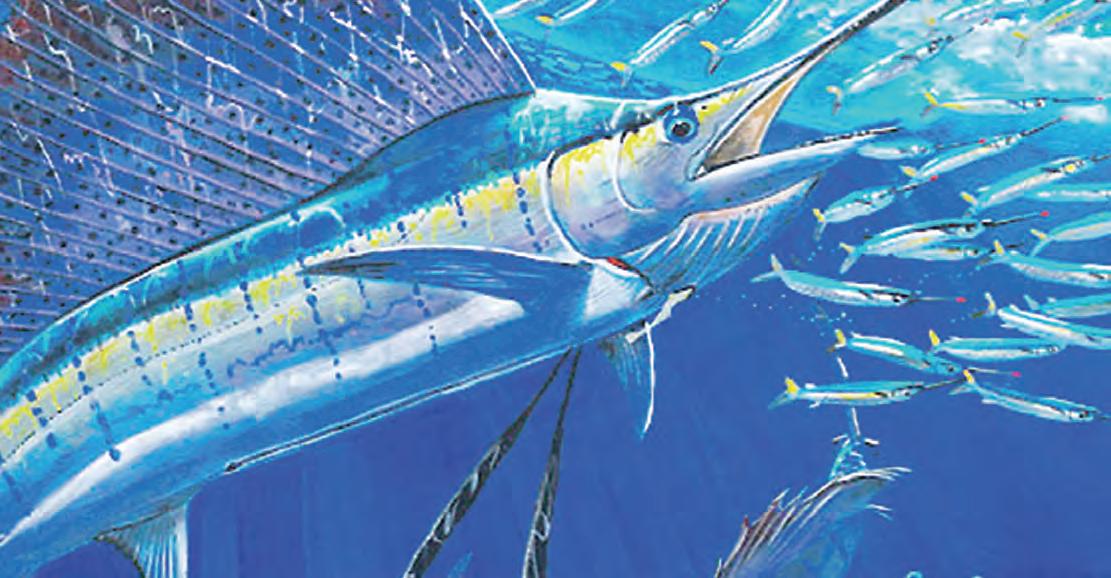
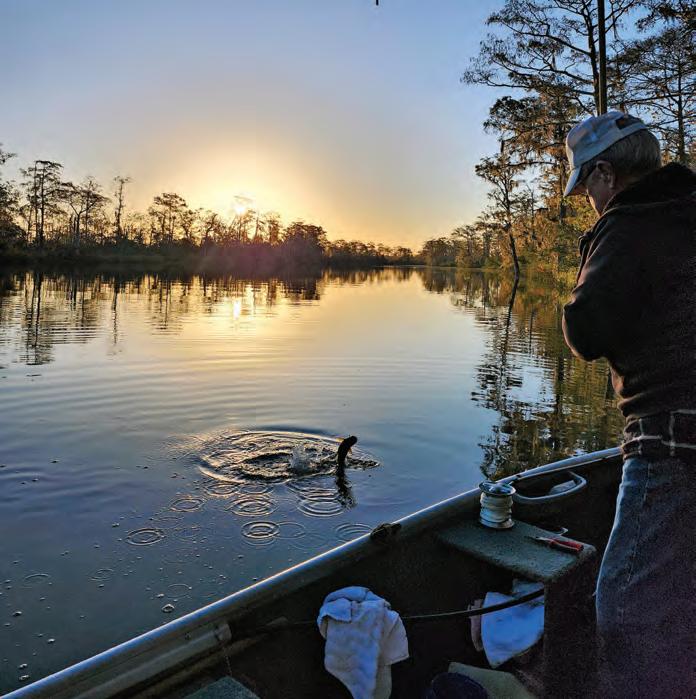

Yuvish Singh nabbed this beautiful 26-inch black drum while wade fishing using a live shrimp as bait.
Debbie Early said this was a wonderful fishing day with a girl and her daddy who is 87 years old. She knows it’s not the biggest catch, but the memories made make it special!
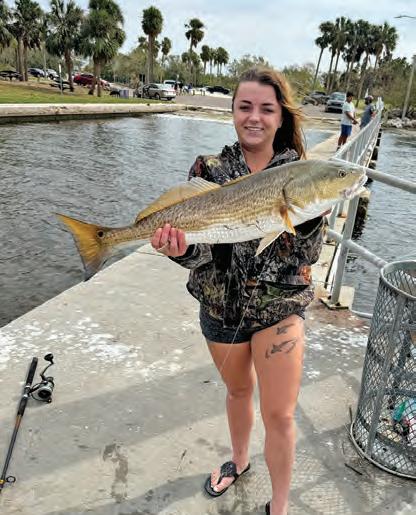
Kylie Harrell with her first redfish, caught pier fishing at Picnic Island Park. She used a couple whole greenbacks on a 2/0 circle hook to land this 32-inch beauty, which she released to live another day.

Ryan Lathrop was wade fishing with his girlfriend when he hooked this 24-inch red using an NLBN swimbait.


Gino Pigoni caught this peacock bass in a South Florida canal using light tackle
For your chance to get featured on the Brag Board, upload your high-quality photos (at least 1MB) with all of the catch details at: www.coastalanglermag.com












internationally and domestically in the destinations where they host each show.
In Sarasota, Informa’s U.S. Boat Show division partners with Mote Marine Laboratory and Aquarium in a fundraising e#ort and opportunity to put leading-edge ocean conservation science into action today. Donations to Mote Marine Laboratory and Aquarium can be made with ticket purchases for the Suncoast Boat Show.
Tickets for this year’s Suncoast Boat Show must be purchased in advance via the website https://www.suncoastboatshow.com/en/home.html Tickets are $20 and children ages 15 and under are free. Veterans and active-duty military show proof of military service for a free ticket. !e show opens on Friday, April 25 at 10:00 a.m. to 6:00 p.m., continuing Saturday, April 26 from 10:00 a.m. to 6:00 p.m. and Sunday, April 27, 2025 from 10:00 a.m. to 5:00 p.m. at Marina Jack, #2 Marina Plaza, Sarasota, Florida.

April 25-27, 2025 and presents an extraordinary selection of sport power boats and motor yachts in water and on land along Sarasota’s luxurious
e Suncoast Boat Show is hosted by the U.S. Boat Show division of Informa Markets, the exhibitions organizer that owns and operates the world’s leading international boat and yacht events. Integral to a corporate culture of sustainability, Informa U.S. Boat Shows has donated thousands of dollars to support multiple initiatives advocating for environmental preservation,
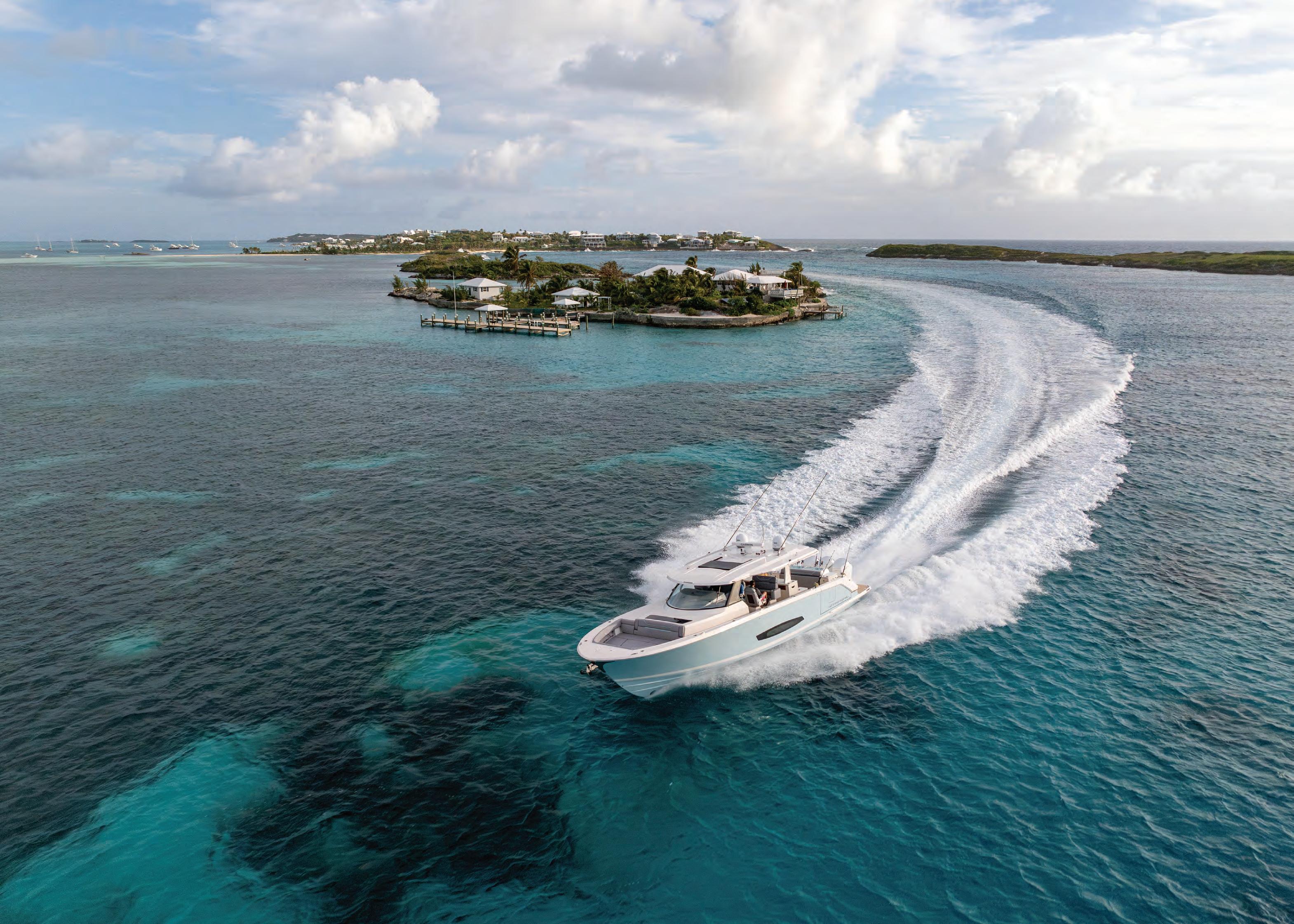
Established in 1955 by Dr. Eugenie Clark, Mote Marine Laboratory is a nonpro t organization working to protect and conserve marine resources. With over
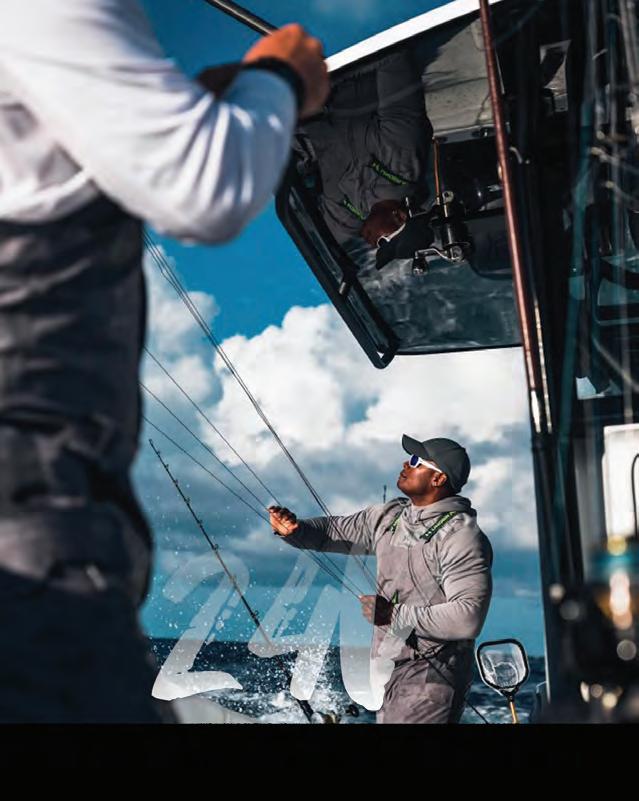
On Saturday and Sunday, well known Sportsman Channel host Captain gives each participant a free rod and reel. Captain Dingman is an expert angler other parents how important it is to spend quality time with their own kids. suncoastboatshow.com. Follow as details are updated on facebook.com/ SuncoastBoatShow; Twitter and Instagram: @suncoastboatshow.









APRIL 25-27


By atch Maguire

Fishing has long been a cherished pastime for millions around the world, o#ering a unique blend of relaxation, excitement, and connection to nature. However, with increasing pressure on aquatic ecosystems, ethical anglers are turning to catch and release shing as a means to enjoy the sport while safeguarding sh populations for future generations. !is practice, when done correctly, provides ecological, educational, and recreational bene ts that extend well beyond the individual angler.
One of the most signi cant advantages of catch and release shing is its role in conserving sh populations. Many popular sh species face threats from over shing, habitat loss, and climate change. By releasing sh back into their natural habitats, anglers help maintain healthy population levels, ensuring that future generations can continue to enjoy the sport.
To maximize the survival rate of released sh, it is essential to handle them properly. Techniques such as using barbless hooks, minimizing handling
time, and avoiding contact with the sh’s gills or slime coat are critical. Tools like rubberized landing nets and sh-friendly dehooking devices further reduce stress and injury, allowing the sh to recover and thrive.
Fish play integral roles in aquatic ecosystems, o$en serving as both predators and prey. Removing too many individuals from a population can disrupt these delicate balances, leading to cascading e#ects throughout the ecosystem. Catch and release shing helps mitigate this risk by allowing sh to return to their environment and continue ful lling their ecological roles. Healthy sh populations contribute to water quality, biodiversity, and the overall stability of aquatic habitats.
Catch and release shing also promotes a deeper sense of ethical responsibility and stewardship among anglers. It encourages a shi$ from viewing shing as purely extractive to appreciating it as an opportunity to engage with nature in a more sustainable way. !is perspective aligns with the principles of conservation-minded organizations, inspiring individuals to advocate for clean water, habitat restoration, and responsible shing practices.
Beyond the ecological bene ts, catch and release shing enriches the overall experience for anglers. Knowing that their actions contribute to conservation can provide a sense of ful llment and purpose. Additionally, the challenge of landing a sh, observing its beauty, and releasing it unharmed adds a layer of skill and respect to the sport. Many anglers report that the act of releasing a sh is as rewarding as catching it, if not more so.
Catch and release shing serves as a powerful teaching tool for younger generations. By involving children and new anglers in this practice, seasoned anglers can instill values of conservation and respect for nature. !ese lessons foster a lifelong appreciation for the environment and encourage responsible outdoor recreation.
In an era where human activities increasingly impact natural ecosystems, catch and release shing stands out as a practice that balances enjoyment with responsibility. By embracing this approach, anglers contribute to the preservation of sh populations, the stability of aquatic ecosystems, and the cultivation of ethical outdoor traditions. Whether shing for sport or relaxation, choosing to release your catch ensures that the thrill of the ght, the joy of connection, and the beauty of nature remain accessible for generations to come.



May 9th & 10th, 2025
Online Registration: MothersDayDolphinTournament.com
Captain’s Meeting
Liechty Marine
Friday May 9th - 6pm to 7pm
Lines In: Saturday, May 10 - 7:30am
Lines Out: Saturday, May 10 - 3:30pm
Weigh-In
Curly’s Co ee
Saturday, May 10th - 3:30pm to 6pm
Awards Banquet
Marathon Yacht Club
Saturday, May 10th - 7pm
Sunday Honor












By A. deGruchy

with lessons about life, responsibility, and the pure joy of shing, as well as expecting the unexpected. Fast forward to today, and I nd myself shing alongside my husband, a charter captain in the Florida Keys.
Fishing here isn’t just a pastime; it’s a way of life. From pulling in powerful Snook to chasing Sail sh on the edge of the reef, every trip o#ers new adventures. My husband and I share a love for shing, and I’ve learned so much about professionalism from watching him do his thing. Whether guiding seasoned anglers or teaching rst-timers, his patience, expertise, and enthusiasm shine. It’s a reminder that professionalism isn’t just about skill, it’s about how you treat people and create unforgettable experiences.
It’s been amazing to see more women embracing shing, from young girls joining family trips to seasoned anglers outpacing the boys on the boat. Even more inspiring is the rise of female captains and mates, rewriting the narrative and proving that grit, determination, and passion know no gender.
Fishing has always been about more than just the catch, it’s about family, adventure, and forging connections, both with the people you’re with and the water itself. Watching women claim their space on the water, competing and winning in major tournaments, and stepping into categories once dominated by men is a powerful reminder of how far we’ve come. Women are now sharing the joy of shing with their partners, landing incredible catches together, and showing that this sport is for everyone. !e waves we’re making are just getting started, and it’s inspiring to see skill and love for the ocean take center stage.
Fishing has long been a tradition passed down through generations, o$en painted as a male-dominated pursuit.
But like the tides, things are changing. Women are stepping aboard boats, rigging lines, and reeling in trophies, proving that the waters are open to everyone. As someone who grew up with a shing rod in hand, I’ve seen this transformation rsthand, and it’s inspiring.
My journey into shing began thanks to my dad. He was the one who introduced me to shing. !ose early days were lled

So here’s to the women who sh, lead, and inspire. May your lines be tight, your horizons wide, and your stories endless.
Whether you’re a seasoned angler or a rst-time sher, let’s create memories together. Book your trip now at www.beansport shing.com and experience the thrill for yourself!
Be sure to follow Astrid’s adventures on Instagram, @catching_astrid and @bean_sport shing.










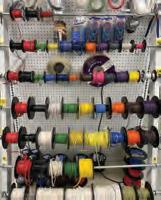
















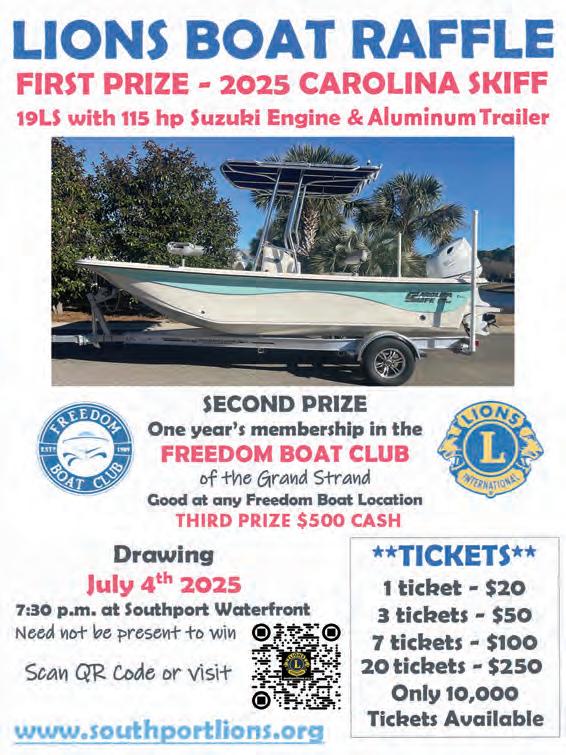
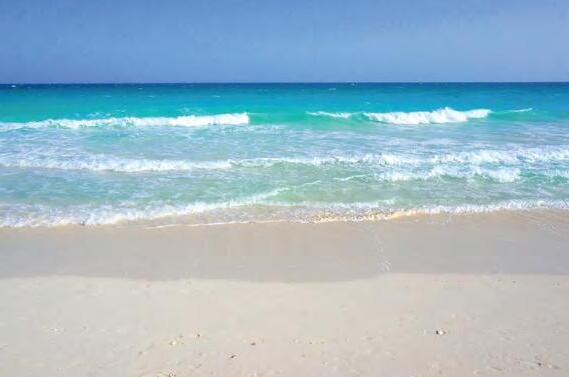
By

The recreational shing industry is on the brink of a technological revolution, with autonomous boating emerging as a transformative force. While self-driving cars have dominated headlines, the development of autonomous boats is quietly reshaping how anglers approach their favorite pastime. !ese advancements promise to enhance safety, e ciency, and accessibility, potentially changing the way people experience shing forever.
One of the most signi cant bene ts of autonomous boating in recreational shing is the ability to optimize navigation. Advanced GPS and AI-driven systems can analyze weather patterns, water conditions, and sh activity to chart the best possible routes. Instead of relying solely on experience or guesswork, anglers could have boats that take them to the most promising shing spots with precision. !is technology reduces the time spent searching for sh and maximizes the chances of a successful outing.




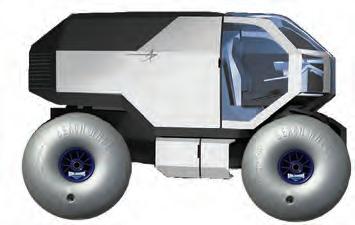


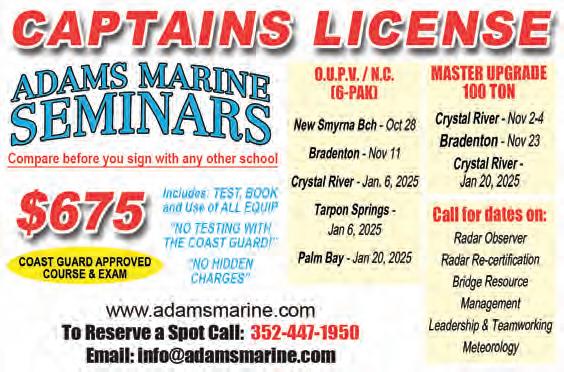
Bradenton - May 12
Clearwater - Jun 2
Tampa/Brandon - Jun 16
Crystal River - July 7 Palm Bay - July 7
Crystal River - May 10-12
Bradenton - May 24-26
Palm Bay - July 19 – 21
Safety is another critical aspect that autonomous boats could improve. Many shing accidents occur due to human error, whether it’s navigating unfamiliar waters, dealing with sudden weather changes, or simply losing focus. With AI-driven controls, boats could automatically adjust speed, avoid obstacles, and even return to shore if conditions become too dangerous. !is level of automation provides an added layer of security, especially for solo anglers who might face emergencies without immediate help.
Accessibility is another area where autonomous boats could make a profound impact. For many, operating a traditional shing boat requires skill, physical e#ort, and extensive knowledge. !ose with limited mobility or minimal boating experience o$en face challenges when trying to enjoy shing on the water. Autonomous technology could allow more people to participate by simplifying the boating experience. With user-friendly controls or even remote operation via a smartphone app, individuals of all backgrounds and abilities could enjoy shing without the steep learning curve associated with traditional boating.
!e integration of smart shing technology into autonomous boats could further enhance the angling experience. Innovations like underwater imaging, automated bait deployment, and real-time sh tracking are already making their way into modern shing gear. When combined with an autonomous vessel, these tools could provide an unprecedented level of e ciency. Imagine a boat that not only takes you to the ideal shing location but also adjusts its position based on sh movement, current ow, and water depth. Such advancements could make shing more productive and enjoyable than ever before.
Despite the promising future of autonomous boating in recreational shing, challenges remain. !e cost of developing and maintaining this technology is still high, potentially limiting accessibility for the average angler. Regulatory concerns also pose hurdles, as governments and maritime authorities must determine how autonomous boats t within existing laws. Additionally, traditionalists in the shing community may resist the shi$ toward automation, arguing that it takes away the skill and personal connection that make shing special.
As technology continues to evolve, autonomous boats will likely become more sophisticated, a#ordable, and widely accepted. Just as GPS revolutionized navigation and sh nders improved catch rates, AI-driven boats have the potential to rede ne the recreational shing experience. While the transition may take time, the possibilities are endless, and the future of autonomous boating in shing looks
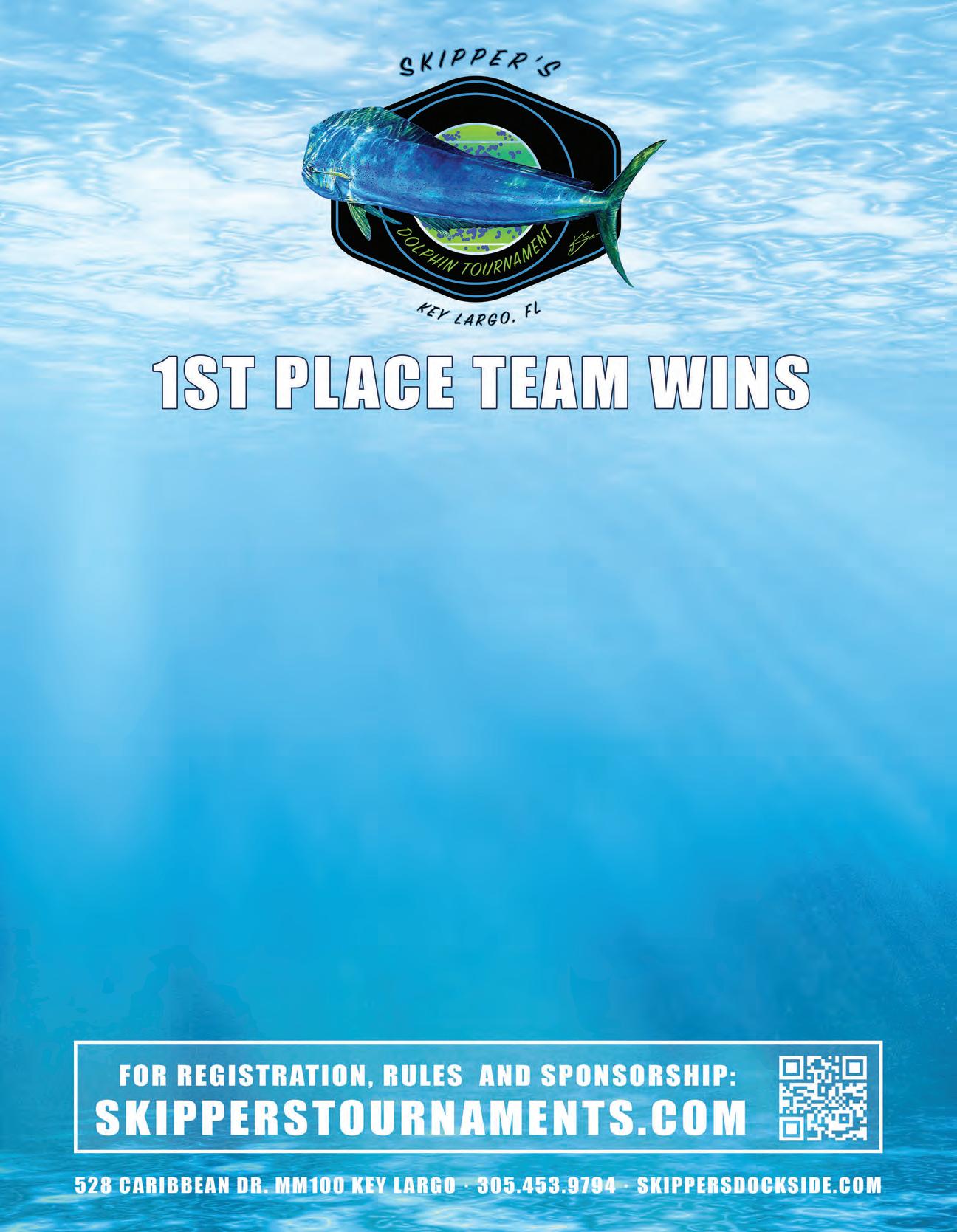




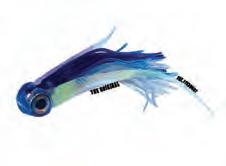

The National Pediatric Cancer Foundation (NPCF) created “Fishing Funds the Cure” to raise awareness and funds for crucial research. Each year, they unite corporate partners, passionate anglers, and dedicated supporters for Fishing Funds the Cure Tournaments through an activity that everyone loves. ese exciting inshore and freshwater shing tournaments are held in beautiful locations like St. Pete Beach and Sarasota, Florida, San Juan, Puerto Rico, and more. Each event, thoughtfully designed to engage supporters, features a kick-o celebration, angler swag bags, an awards dinner and a silent auction, all dedicated to making a meaningful impact.
NPCF organizes these events to blend the universal love for shing with an important cause. eir mission is to conduct research leading to less toxic and more therapeutic treatments for children with cancer, and are committed to making a di erence in a system that o$en neglects our children. Despite their bright futures, only 4% of government funding for cancer research supports pediatric initiatives, highlighting the urgent need for advocacy.
NPCF has made remarkable progress and is recognized as the nation’s leading solution, delivering rapid, innovative, and e%cient science
through a collaborative network of 40 hospitals. Operating independently of pharmaceutical and government funding, with eight institutions noted in the “Top 20” by US News, they have invested over $40 million in translational studies and clinical trials. NPCF currently have 30 studies and 11 active trials:
• A new drug compound – which could be the 11th drug utilized to treat children
• Blood bio-marker study – which could be a prevention indicator for relapse patients
• A rare disease trial addressing “rhabdomyosarcoma”
• Multiple combined immunotherapy trials to include a potential vaccine
• NPCF has also authorized the “ rst-ever” education toolkit – provided to pediatric cancer families
• ey are also developing treatment guidelines for relapse patients
If shing is your passion, NPCF invites you to channel that enthusiasm toward a worthy cause. Join them at one of their tournaments, organize your own fundraising event, or take on their “43 Challenge” to honor the 43 children diagnosed

with cancer every day. You can easily start by using NPCF’s online fundraising tool, challenging 43 friends to sh, and encouraging them to donate $43.
e National Pediatric Cancer Foundation is proud to be a top-rated charity, with 89% of every dollar donated directly supporting research. To learn more, visit NationalPCF.org.
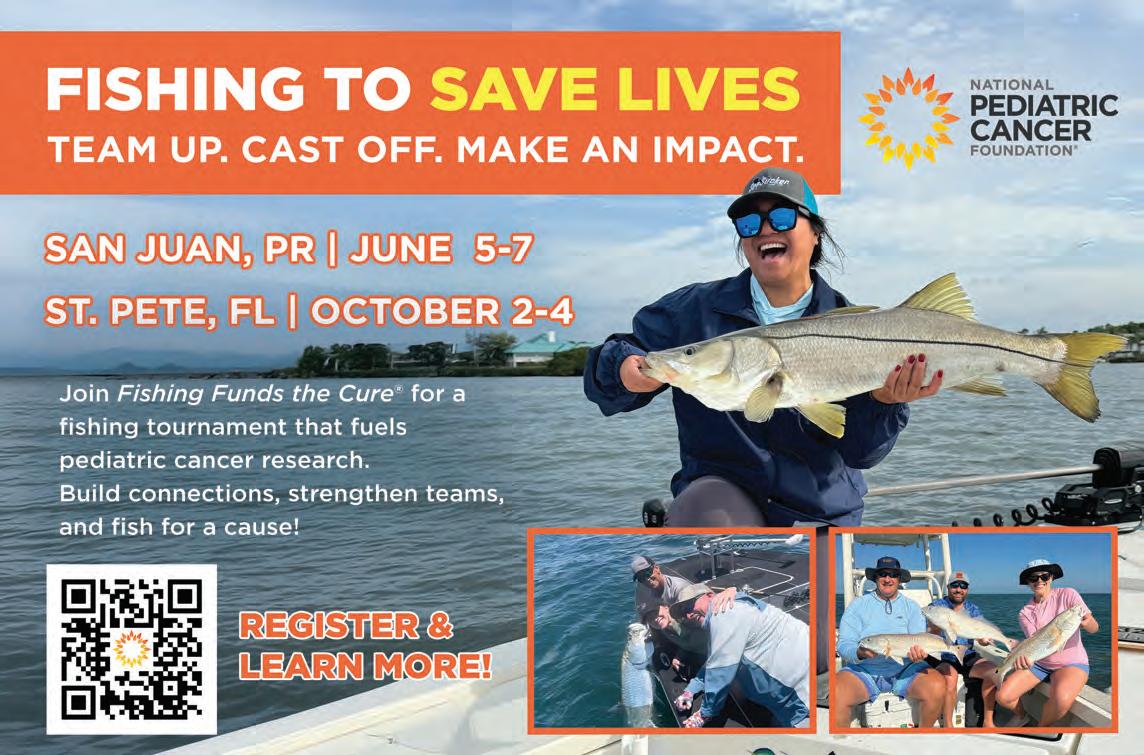
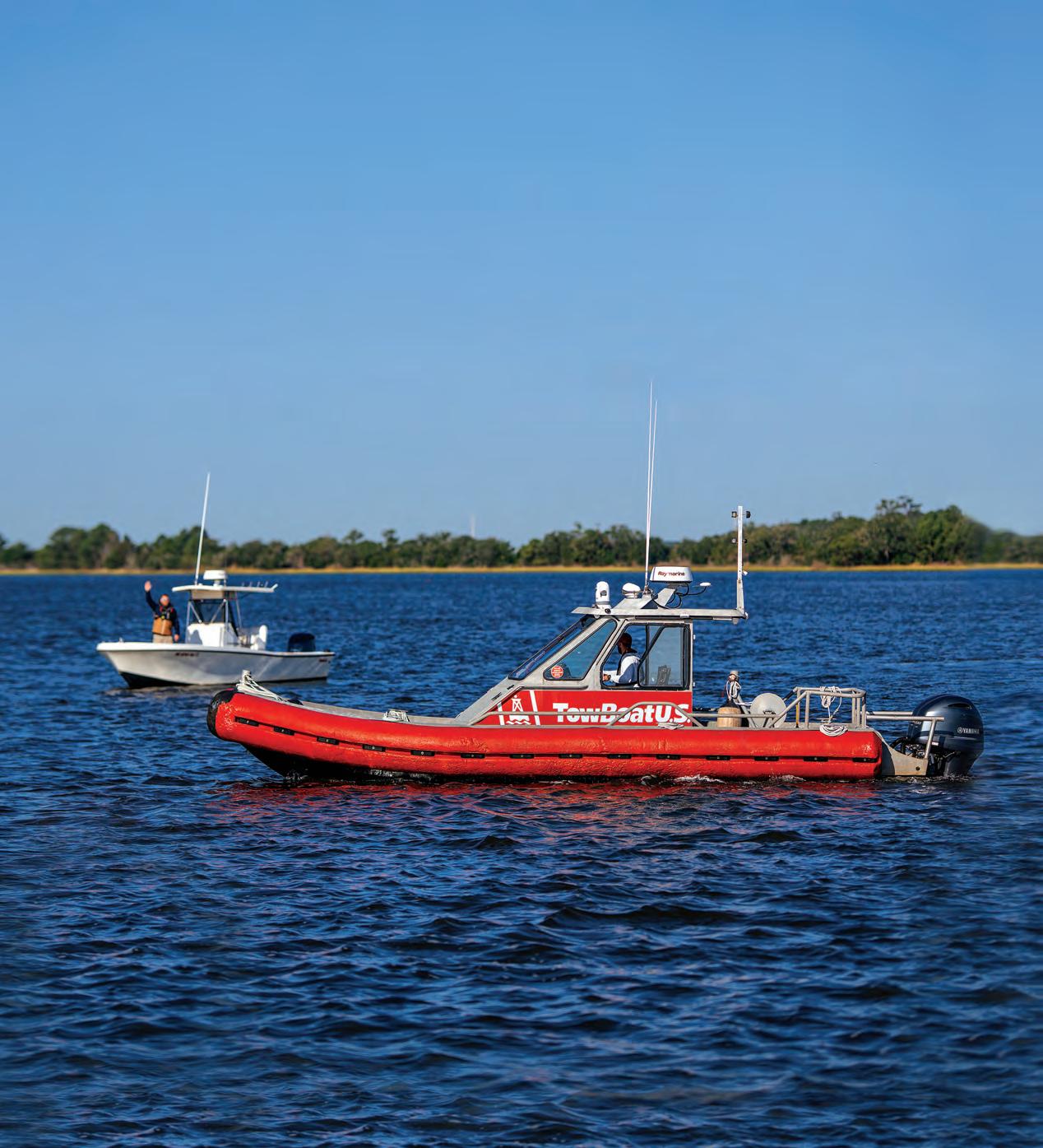




The month of April is when the real change comes around. For a number of reasons, April can be a game changer. Just for starters, we have made it out of the month of March and the “Gales of March.” !e temperatures will rise, the daylight hours will be longer, and the urge to spawn will get stronger for a lot of species.
!e pelagics will be on the march up the coast headed north, and I have taken a much di erent approach to shing in general, but especially for the pelagics. Sure, we may troll for a short period in the morning to mark some bait and/or productive bottom holding sh like African pompano, big snapper and grouper, but trolling will quickly stop and dri$ing and/ or %ying the kite will begin as the sun rises in the sky. As the title of the article suggests, we have either stopped on the way out or will start to work with the Sabiki right away.
!is is the key: when you have the live bait, you get the bites. Don’t hesitate to bring bait from the dock like pin sh, menhaden, etc. to use as light-line kite bait or bottom bait. Sometimes it’s just easier to pull up beside the bait barge and exchange some green for sardines, cigar minnows, goggle eyes, etc., so you can just get on with getting to where





Tim Barefoot

you’re going and start shing right o the bat. When you nd a good mark of bait, and hopefully bottom structure, the stage is set. Put the kite %oats, tackle or freelines out and start sending the jigs to the mid or lower water

column, and even to the bottom. Of course, I like a natural looking squid jig you can cast to breaking sh that’s heavy enough to sh in the mid to lower water column or a few hundred feet deep when needed on the bottom. the
entire time you were harvesting sh on the jig pay attention to the free line or %oat baits and keep some chum going if possible. !is is a great way to bring the sh to you. !ey will de nitely come to the chum.
As always, I would pay attention to the amount of noise you make. Don’t let cooler lids slam down or hard objects hit the deck; this will send a soundwave hundreds of yards away from the boat telling the sh something isn’t right. If you’re dri$ing quietly with a chum slick out and beautiful live baits, you have a recipe for success!
!is is a great time of year to catch that African pompano of a lifetime in 150- to 250foot range as they are ready to break up into smaller schools for spawning. Again, I like a squid-type jig because it is the primary food source for the African pompano. It is the bulk of their diet according to the experts. And it’s not just African pompano; everything out there, without exception, eats a squid. !is is a great way to catch big snappers as well. Pull up to where the marks are, make a dri$ and repeat as o$en as needed. A trolling motor upfront can slow the dri$ nicely, keeping your boat forward in the wind with the kite bait or %oat, and baits behind the boat very manageable.
And be sure to keep an eye on the recorder to know where to keep the jig in front of sh.
For more info on the squid jig and dri ing, check out Tim Barefoot’s YouTube channel and website, barefootcatsandtackle.com.
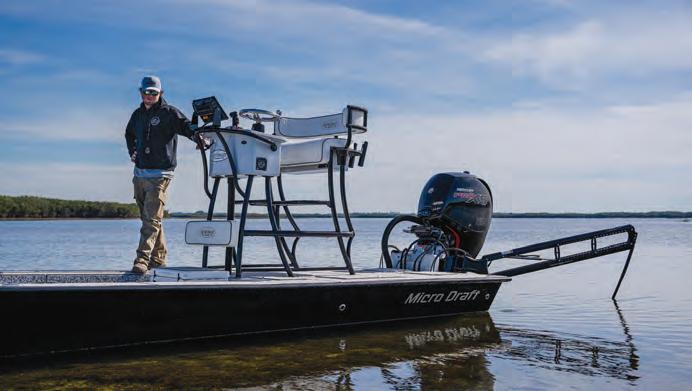





It was a warm summer afternoon and my wife and I were mingling with the best of them. The occasion was a 1920s-themed party, and everyone was dressed to the nines. Parked on the manse’s circular driveway was a beautiful classic convertible. It was here that I got the idea for our new 1920s Retrograde Watch.
Never ones to miss an opportunity, we carefully steadied our glasses of bubbly and climbed into the car’s long front seat. Among the many opulent features on display was a series of dashboard dials that accentuated the car’s lavish aura. One of those dials inspired our 1920s Retrograde Watch, a genuinely unique timepiece that marries timeless style with modern technology.

With its remarkable retrograde hour and minute indicators, sunburst guilloche face and precision movement, this design is truly one of a kind. What does retrograde mean? Instead of displaying the hands rotating on an axis like most watches, the hands sweep in a semicircle, then return to their starting point and begin all over again.

Retrograde watches by the big brands can set you back thousands; one recent offering from a big French fashion house is selling for more than $150,000! But because we’ve designed the 1920s Retrograde Watch in-house, we can offer it to you for just $99!
This watch is so wildly popular with our customers that we’re actually concerned about running out; we only have 937 729 left for this ad!
Join more than 1 MILLION smart people who love stauer watches

Watch Specifications:
• Precision movement
• Stainless steel case, caseback and crown
• Retrograde hour and minute indicators
• Water-resistant to 5 ATM




• Brown genuine leather band
• Fits wrists up to 8"
1920s Retrograde Watch
$399 $99* + S&P Save $300


*Special price only for customers using the offer code.





“An elegant and exciting timepiece that every collector will love.”
— George Tomas, internationally renowned watch expert



“[A] unique and beautiful timepiece.”
— Carlos C., Los Banos, CA





By Don Norton
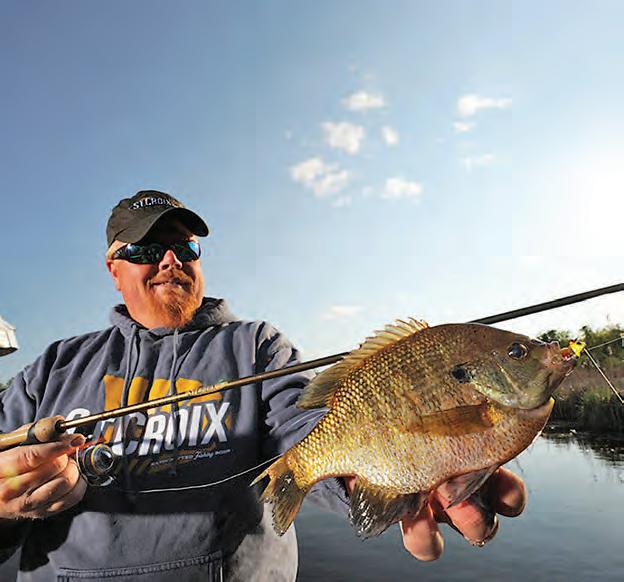
Most anglers think of Lake Okeechobee, Florida, and many other great shing lakes as a destination for largemouth bass. And they truly are. But for those in the know, “Lake O” boasts some of the greatest bluegill shing you’ll nd anywhere in the country.
!is is the time of the year—April and May—that bluegill anglers look forward to all year long. !is is when the feisty, hard- ghting pan sh begin their annual spawn. !eir popularity is unmatched with young and experienced anglers looking to test their light line and tackle.
While bluegill is a single species (Lepomis macrochirus), it is sometimes categorized into three subspecies: the northern bluegill, the coppernose
bluegill, and the southwestern bluegill.
To add to the confusion, redear sun sh and bluegills, both belonging to the sun sh family, are easily confused, but can be distinguished by the red or orange coloration around the redear’s operculum (gill %ap), while bluegills have a dark blue to black operculum. Redear sun sh typically grow larger than bluegills, but are o$en caught in the same area, as are coppernose bluegill.
Bluegills are so plentiful that many anglers come to Lake Okeechobee every year just for them and go home with coolers full of their tasty lets. !e daily limit is $y pan sh per angler, and that’s not a hard number to reach when the season is in full swing.
Bluegills can be caught year-round, but when they come into the shallows to spawn, they become a much easier target. Many anglers will test their skills with a %yrod and small popper, while others will use live bait, light line, and tackle—and even bamboo cane poles!
On average, bluegill typically range from six to eight inches in length, although some can grow up to 10 to 15 inches. Nine inches is considered a decent keeper in the “Big O.”

To rig for bluegill, use a small hook (size 8-10) with a light line, a small split shot a few inches above the hook, and a bobber set to suspend your bait near the bottom; commonly used live baits include small worms, waxworms, or crickets, and you can also try small jigs or tiny so$ plastic baits depending on the situation and water depth.
When it comes to the time of day that produces the best bluegill shing, many anglers recommend early evening. As the sun begins to set, waters tend to calm down and %ying insects quickly become a big part of the menu.
But during the spawn, bluegills can be caught all day long.

Finding the beds is relatively easy. Just look in shallow water, 5-foot deep or less for small circular divots in the sandy bottom. !ese “beds” will o$en be close together and will sometimes number in the hundreds.
!e world record bluegill—a sh weighing 4 pounds, 12 ounces— was caught in 1950 in Ketona Lake, Alabama with a cane pole and common worms.
Don Norton is Co-Publisher of Coastal Angler Magazine’s Okeechobee edition. Contact him at (863) 273-4998 or don@theanglermagazine.com.














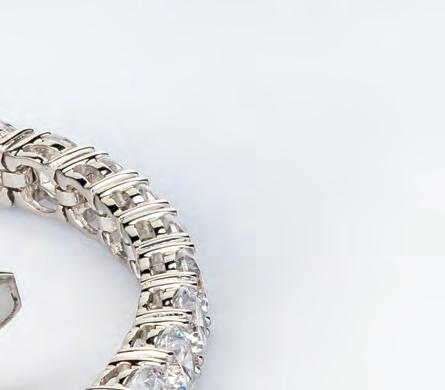

Praise for DiamondAura®
“So much sparkle and the play of light on DiamondAura® beats any diamond!” — D.D. from Columbus, OH
A classic tennis bracelet serves up over 10 carats of sparkle for a guaranteed win
It was the jewelry piece that made the world stop and take notice. In the middle of a long volley during the big American tennis tournament, the chic blonde athlete had to stop play because her delicate diamond bracelet had broken and she had to fnd it. Te tennis star recovered her beloved bracelet, but the world would never be the same.
From that moment on, the tennis bracelet has been on the lips and on the wrists of women in the know. Once called eternity bracelets, these bands of diamonds were known from then on as tennis bracelets, and remain the hot ticket item with jewelers.


with D Flawless diamonds from another company that costs $57,000!
Want to look like a million bucks without stressing over losing or damaging something that cost you a fortune? Te Love Wins Tennis Bracelet is a simple strand of glittering gems in precious sterling that epitomizes elegance.
FREE earrings with your purchase of the Love Wins Bracelet.
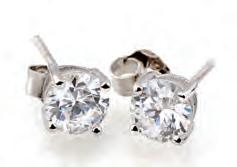
Te frst time we ofered this bracelet, we sold out literally in minutes. It was our fastest selling product of 2021. It took six months to get it back in stock — Get yours before we run out!
And there’s more... we will also include our Ultimate Diamond Alternative™ DiamondAura® stud earrings for FREE!
Jewelry Specifcations:

• 10 ¾ ctw of the Ultimate Diamond Alternative®, DiamondAura®
• Rhodium-fnished .925 sterling silver settings
• Bracelet: Fits wrists to 7 ½". Earrings: 1 ctw with post backs


We’ve captured this timeless classic with over 10 total carats of DiamondAura®, our signature diamond alternative stone. Tis sparkling marvel rivals even the fnest diamonds (D Flawless) with its transparent color and clarity, and both are so hard they can cut glass. Don’t believe me? Te book “Jewelry and Gems – Te Buying Guide,” praised the technique used in our diamond alternative DiamondAura®: “Te best diamond simulation to date, and even some jewelers have mistaken these stones for mined diamonds,” it raved. For comparison, we found a similarly designed 10 carat tennis bracelet
Love Wins Tennis Bracelet (10 ¾ ctw) $399 $39* + S&P
FREE stud earrings (1 ctw) with your purchase of the Love Wins Bracelet — a $99 value!
*Special price only for customers using the offer code.

Your Offer Code: LWB343-02
TYLER WOOLCOTT

ne of my all time favorite times of year to fish with one of the most fun ways to catch a bass. The spawn and post spawn feed is here for most of us in the south and it won’t be long for many others in the other parts of the country. There is a plethora of ways to catch these bass, but my all time favorite for getting bit and drawing in a big one is a hollow body popping frog.
A popping frog can be used as an incredible search bait, duplicating many different baitfish depending on where you throw it and what color you tie on. There are many different options out there, but I try to duplicate the baitfish forage in the particular lake I am fishing on. Sometimes I will stick to a frog that may imitate a bluegill, and sometimes I throw a color that would imitate a shad. Finding a frog that pops well, has good colors, and a big hook is a few things that need to check the boxes for me. The Gambler popping frog is good and so is the Spro.
When I throw a frog as a search bait, I like to work it faster than most. Cover as much water as possible until you put a pattern together on what exactly the fish are focusing on. That’s the magic of a frog; you can literally throw it around everything! Docks, lay downs, grass and down banks are just a few of the targets I would look for. Once you locate a group of fish or find that right area that they are using you can slow down and pick them off a little slower. I have noticed sometimes there isn’t a “too fast” while working a popping frog.
A couple things that I look for this time of year are areas with active fish spawning, fry guarding bass, and also fish roaming the banks feeding on bluegill. This is something that is very predictable and an awesome way to catch big ones when you get around it. Typically, if you know of a few areas that the fish had previously spawned, these patterns will be occurring in the same areas. I throw a bluegill pattern popping frog because the bluegill will typically be a fish that chase their fry and a fish that drives them crazy this time of year.
Another pattern that you might want to keep your eyes out for is a shad spawn. This usually occurs in the mornings and in the evenings and can be a way to catch a bunch of fish in a hurry. We typically look for birds feeding on banks while running down the lake; you find the birds, you find the bait! A white popping frog or a baitfish color is typically my choice in this situation as a lot of times these fish are so keyed in on the baitfish that you’ll want to match the hatch.
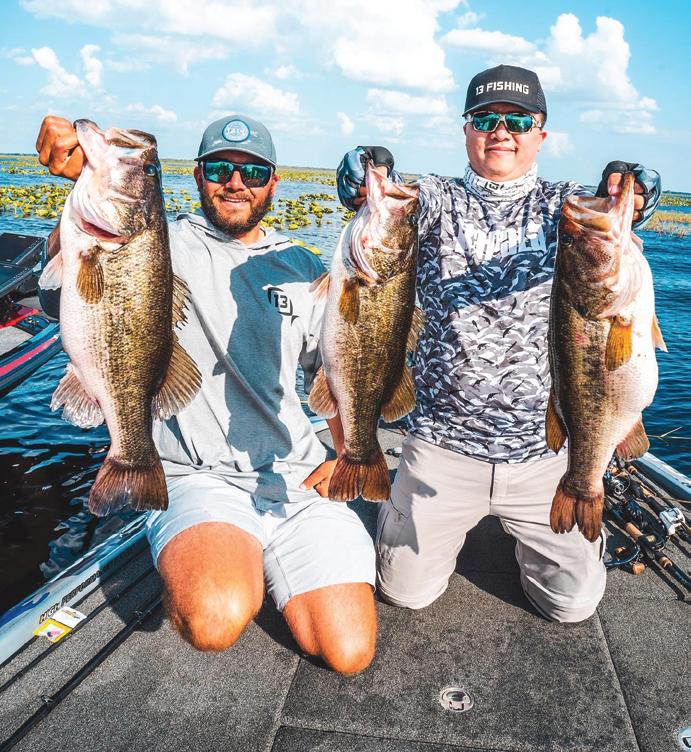
A popping frog can work all year long, but this time of year I think it excels the greatest. It’s an incredible search bait that really drives these fish crazy, and who doesn’t like catching fish on a topwater with heavy line and a heavy rod? Grab a popping frog and go catch some big bass! Frog Fishing Gear: Typically when throwing a popping frog you will be around some heavy cover and need to have some big hooks to get through the fish’s mouth. This calls for a heavy rod, some big line and a fast-geared reel. I like to throw a 13 Fishing 7’4H Myth rod paired with a Concept A 8.3 reel spooled up with Sufix 832 50 lb. braid. This setup will allow you to get the fish out of the heavy cover and into the boat.
Tyler Woolcott is a professional tournament angler and guide. Check out his website at www.tylerwoolcottfishing.com.

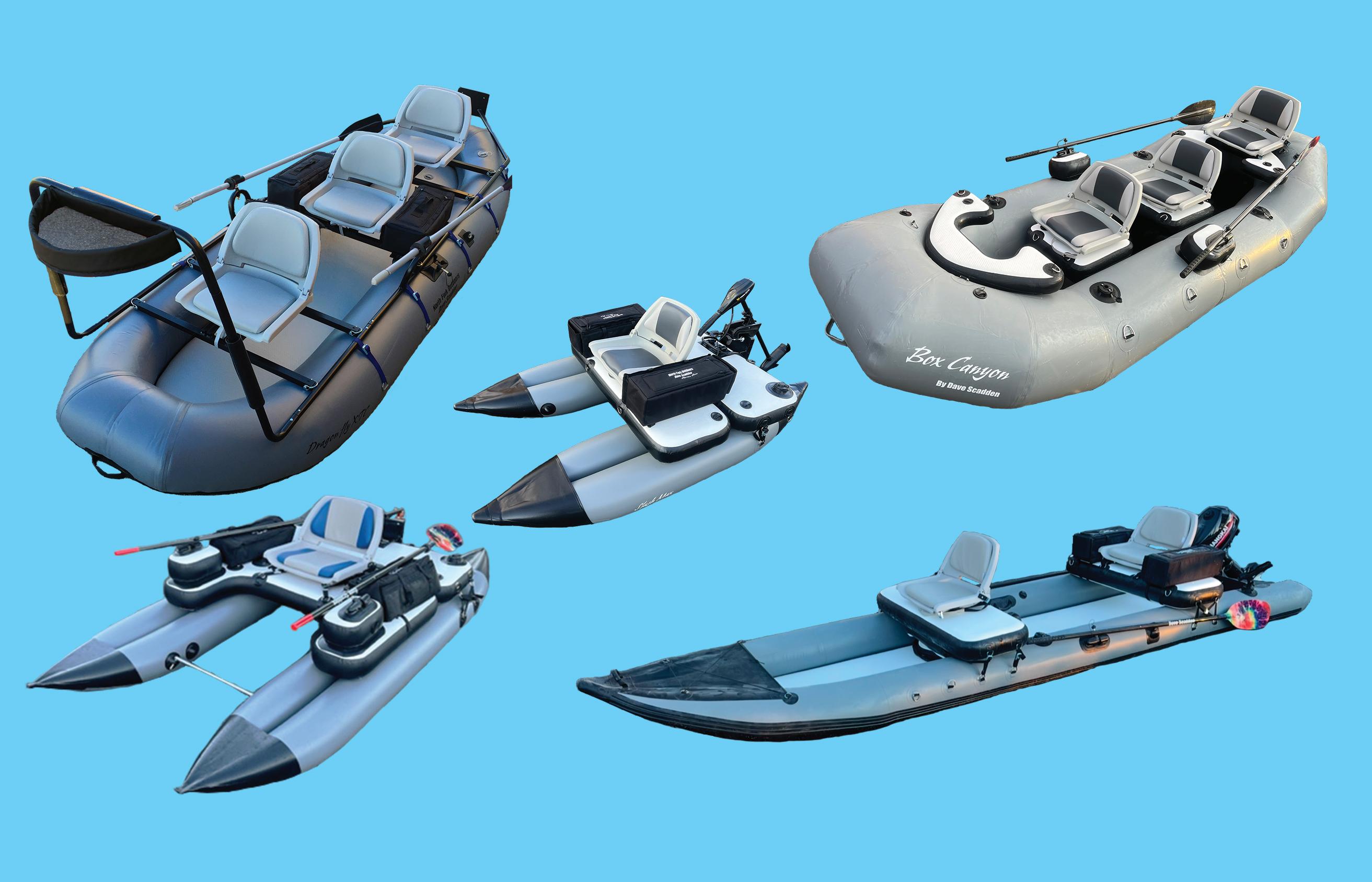





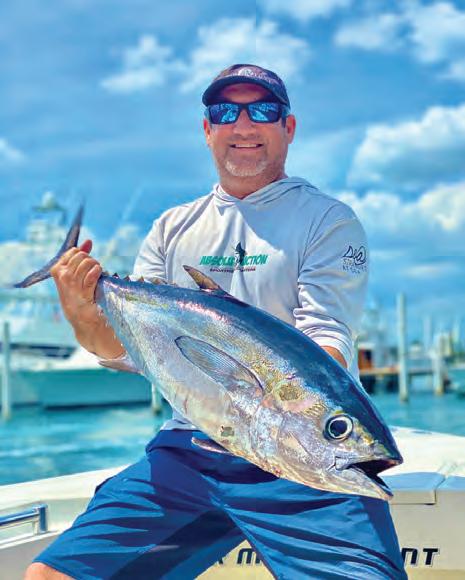







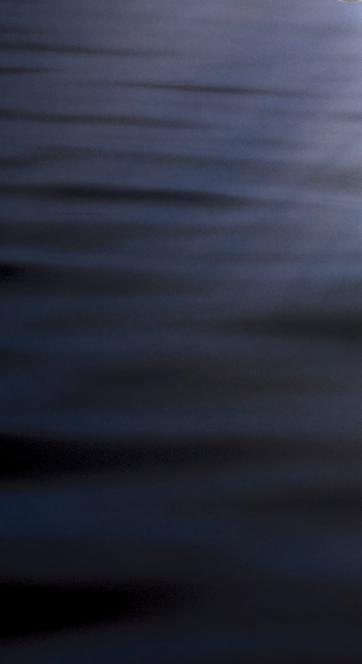




You’re looking at it! Furuno’s award-winning Radar gives you clarity & target separation like no one else. Don’t take our word for it. See for yourself. Scan here, and we’ll show you! DRS4DNXTDRS6ANXT




